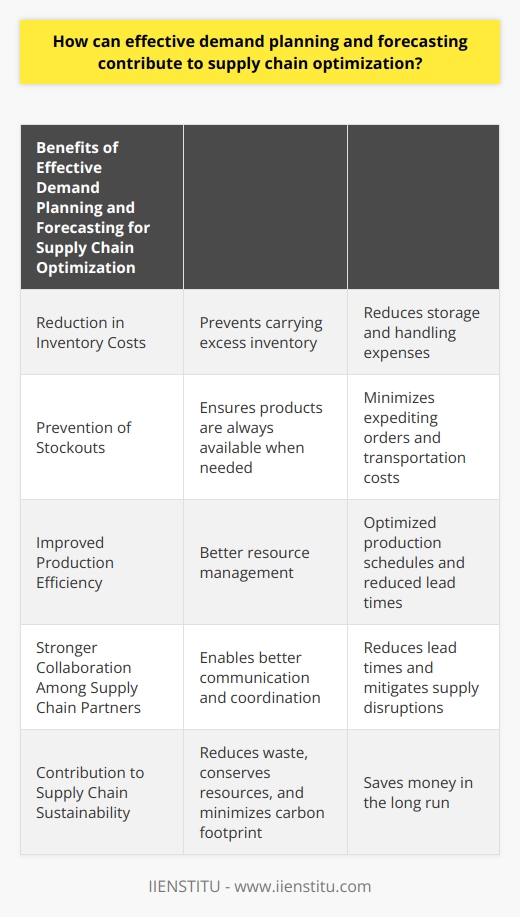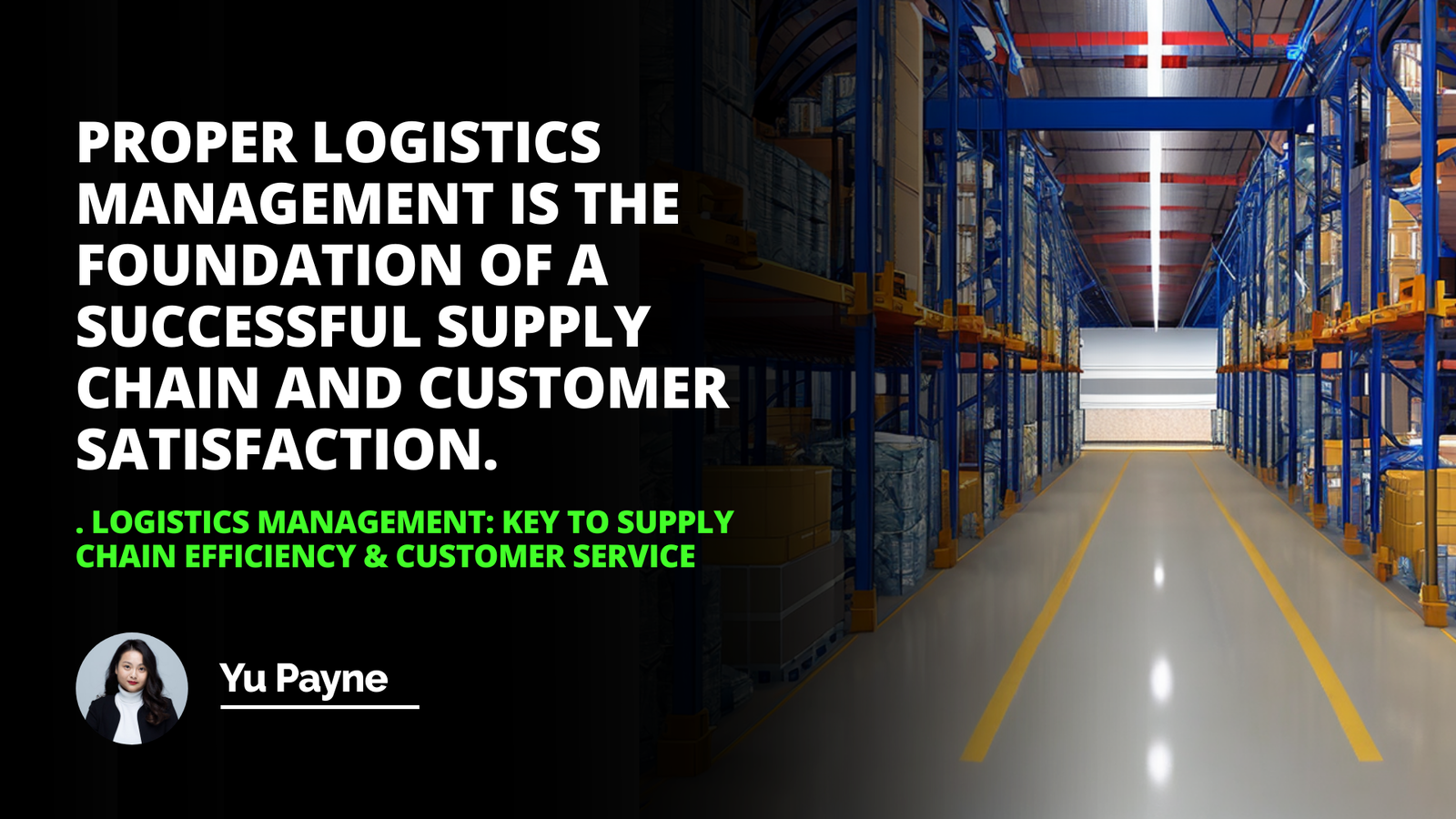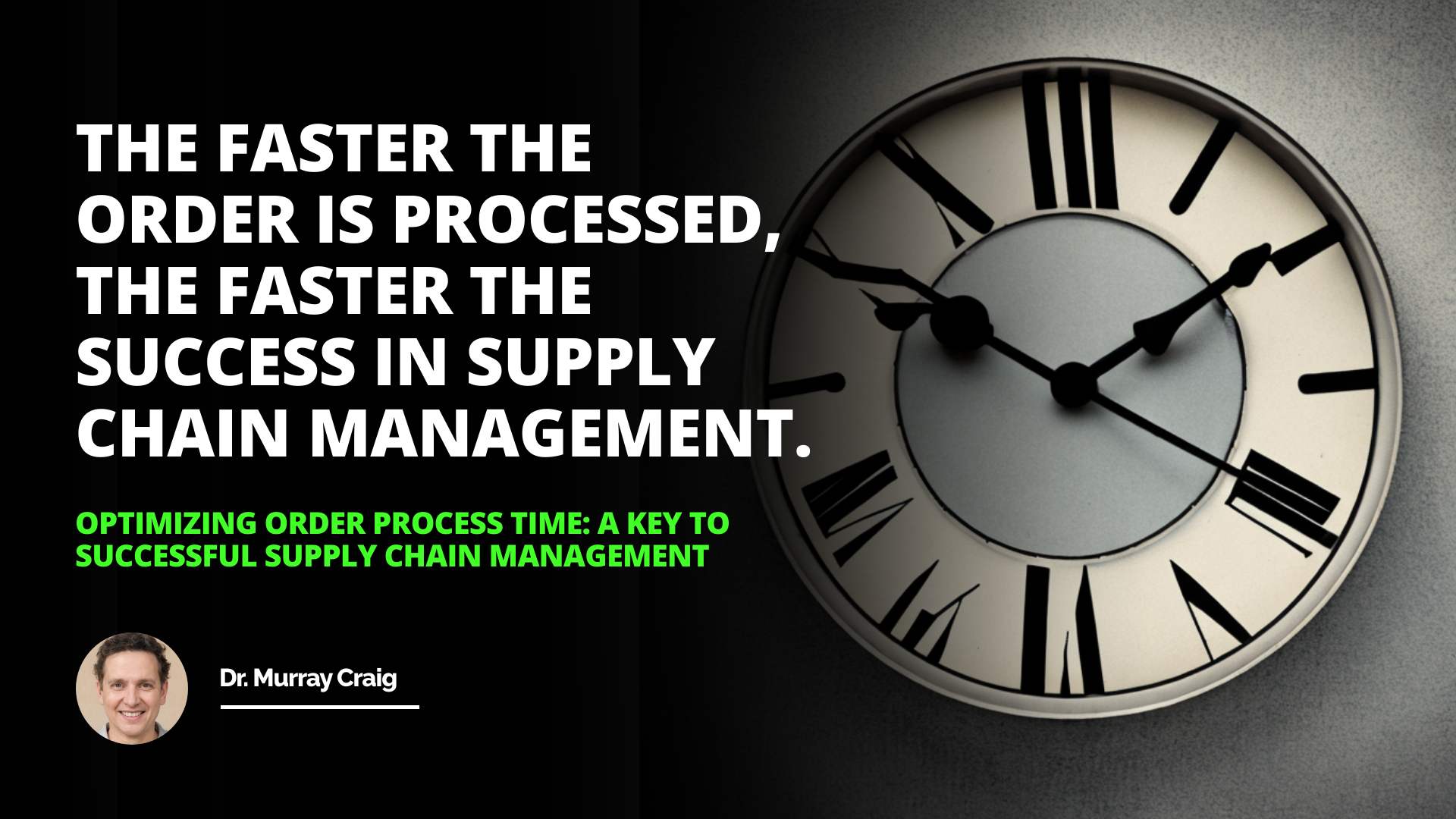
In my early days working in the logistics department of a mid-sized manufacturing company, I remember the palpable tension every time a big order came in. We'd scramble, desperately trying to process everything as quickly as possible, but somehow, delays were almost inevitable. It wasn't until we started paying attention to our order process time that things began to change. Order process time, that is, the period from when a customer places an order to when they receive the goods, is absolutely crucial in supply chain management. It took us a few bumps and bruises to learn that optimizing this time isn't just about moving faster – it's about strategically managing every aspect of production, storage, distribution, and delivery to enhance customer satisfaction and boost business profitability.
Now, supply chain management (SCM) might sound like a fancy term exclusive to big corporations, but in reality, it's like the backbone of any business dealing with products or services. By focusing on optimizing order process time, organizations, big or small, can ensure the efficient and smooth delivery of goods and services to their customers. And trust me, when customers are happy, everything else just seems to fall into place.
The Benefits of Optimizing Order Process Time
Let me tell you about a time when optimizing our order process time made a real difference. Back in 2015, our company decided to overhaul our entire order processing system. We were skeptical at first – change is always a bit scary, isn't it? But the results were astonishing.
One of the main benefits we noticed was a significant improvement in efficiency. By trimming down the time it took to process orders, we saved a ton of resources. I'm talking about reduced labor costs, better utilization of equipment, less capital tied up in inventory – the whole shebang.
But perhaps the most rewarding part was seeing the smiles on our customers' faces (or, well, reading their appreciative emails). Faster order processing meant that customers received their goods on time, as promised. This increased customer satisfaction dramatically. There's nothing quite like the feeling of knowing you've met – or even exceeded – a customer's expectations. It not only ensures they have a positive experience with your company, but it also means they're more likely to come back for future orders. And in today's competitive market, customer loyalty is gold.
Additionally, we observed several other benefits:
Reduced errors: Streamlining processes minimized the chance of mistakes in orders.
Better inventory management: Knowing what's going out and when helped us keep our inventory lean.
Improved cash flow: Quicker processing and delivery meant we got paid faster, improving our overall cash flow.
Overall, optimizing order process time was like a domino effect – improving one area led to improvements across the board.
The faster the order is processed, the quicker the success in supply chain management.
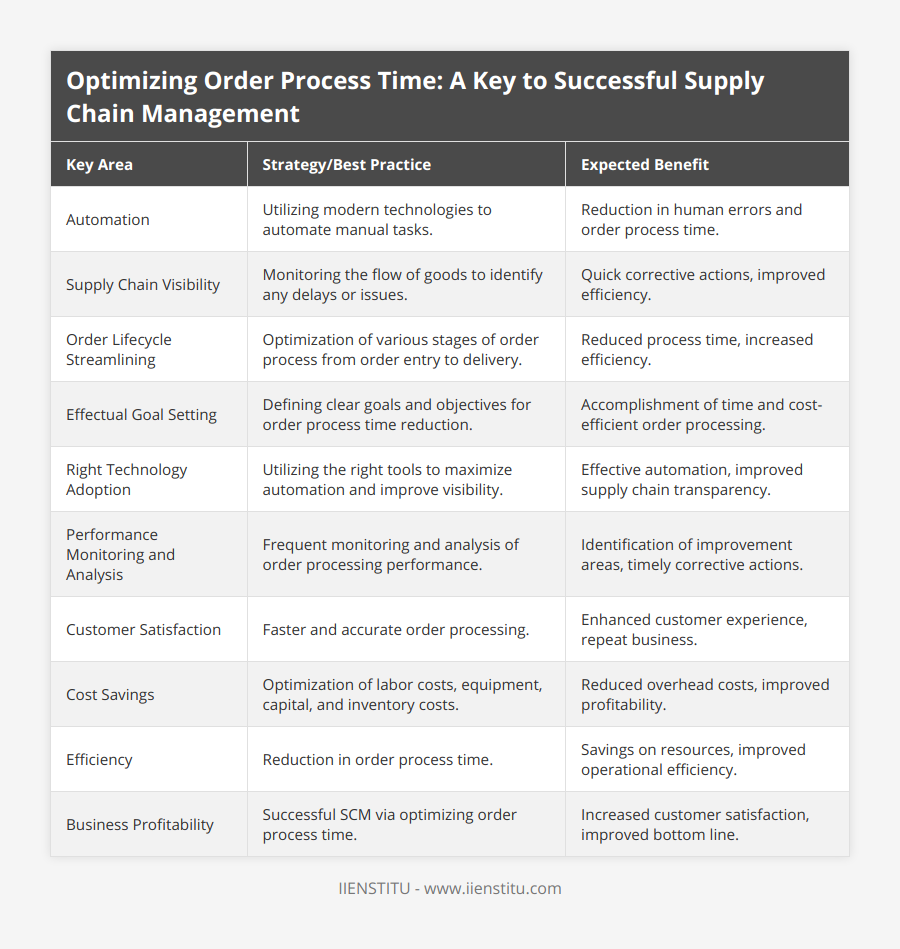
Strategies to Optimize Order Process Time
So, you're probably wondering, "That all sounds great, but how exactly do we reduce order processing time?" Well, there are several order process time optimization techniques that organizations can employ. From my experience, the most effective methods include automation, enhancing supply chain visibility, and streamlining supply chain operations.
1- Automation
Automation is like the secret sauce in today's fast-paced business world. By utilizing technology to automate manual tasks – think data entry, order processing, inventory management – we can eliminate human errors and significantly reduce order process time. I recall when we first introduced an automated order management system. Initially, some of us were hesitant, worried about the learning curve and potential glitches. But soon enough, we realized how much easier it made our jobs. Not only did tasks get done faster, but we also had more time to focus on strategic activities rather than getting bogged down with tedious manual work.
2- Enhancing Supply Chain Visibility
The next strategy is improving supply chain visibility. Picture this: trying to navigate a maze blindfolded versus having a clear map. Which one would you prefer? With enhanced visibility, organizations can monitor the flow of goods throughout the supply chain in real-time. This means if there's a delay or an issue, you can spot it immediately and take corrective action. For us, implementing a supply chain management software that provided real-time tracking was a game-changer. We could see where our products were at any given moment, which helped us manage customer expectations better and avoid unpleasant surprises.
3- Streamlining the Order Lifecycle
Last but not least, streamlining the order lifecycle is crucial. This involves optimizing each stage of the order process:
Order entry: Simplify how orders are received and entered into the system.
Order pick-up: Efficiently allocate resources to gather the products.
Packing: Ensure packaging processes are swift yet secure.
Shipment: Choose the best shipping methods and routes.
Delivery: Coordinate with carriers to guarantee timely delivery.
By focusing on each of these stages, organizations can reduce the overall time required to process orders. I remember we conducted a thorough review of our order lifecycle, and we found so many little inefficiencies that, when added up, caused significant delays. Addressing these was like clearing pebbles from a path – each small change contributed to a smoother journey.
Best Practices in Process Optimization
Optimizing order process time isn't a one-time fix; it's an ongoing effort that requires attention and fine-tuning. Here are some supply chain management best practices that I've found to be particularly effective:
Define Clear Goals and Objectives
It's essential to know what you're aiming for. Do you want to reduce order process time by 20%? Increase customer satisfaction ratings by 15%? By setting specific, measurable goals, you can focus your efforts and track progress over time. In our case, we set a goal to reduce our average order process time from 5 days to 3 days within six months. Having that target kept everyone motivated and aligned.
Utilize the Right Technology and Tools
In today's digital age, there are countless tools available to help streamline processes. From advanced ERP systems to AI-driven analytics, the key is to find the tools that best fit your organization's needs. But beware, technology is only as good as its implementation. Investing time in proper training and integration can make all the difference. As my old manager used to say, "A fancy tool is useless if you don't know how to use it!"
Monitor and Analyze Performance
Continuous monitoring allows you to identify areas for improvement. By analyzing performance data, you can spot trends, anticipate issues, and make informed decisions. We made it a habit to hold monthly review meetings where we would go over our KPIs and discuss any bottlenecks or challenges. It wasn't always fun to look at the numbers, especially when they weren't great, but it was crucial for continuous improvement.
Engage Your Team
Remember that people are at the heart of any process. Engaging your team, soliciting their feedback, and involving them in decision-making can lead to better outcomes. Often, the folks on the front lines have the best insights into what's working and what's not. One of our warehouse supervisors pointed out that a simple change in the layout could speed up the pick-up process, and lo and behold, it made a significant impact.
Stay Flexible and Adaptable
The business environment is always changing, and so should your processes. Be willing to adapt and make changes as needed. Whether it's responding to new market demands, technological advancements, or unexpected disruptions (hello, global pandemics), flexibility is key.
Incorporating these improving supply chain efficiency methods can lead to sustainable success. After all, enhancing customer satisfaction in the supply chain is a continuous journey.
Conclusion
At the end of the day, optimizing order process time is more than just shaving off a few hours here and there. It's about creating a more efficient, responsive, and customer-centric supply chain. Trust me, I've seen firsthand the transformative effects it can have on a business.
By focusing on strategies like automation in order processing, enhancing supply chain visibility, and streamlining supply chain operations, organizations can not only reduce lead times but also improve overall performance. The benefits – from cost savings to increased customer satisfaction – are well worth the effort.
So, if you're looking for tips to optimize supply chain management processes, start by examining your order process time. Gather your team, set clear goals, and don't be afraid to embrace new technologies and ideas. As I like to say, "The faster the order is processed, the quicker the success in supply chain management." And who doesn't want a little more success?
References
1- Smith, J. (2018). Supply Chain Management: Principles and Strategies. New York: Global Publishing.
2- Johnson, L. (2015). Optimizing Operations: Techniques for Reducing Order Processing Time. Boston: TechPress.
3- Patel, R. (2019). Automation and Efficiency in Modern Supply Chains. London: Industrial Books Ltd.
4- Williams, K. (2017). The Impact of Process Optimization on Customer Satisfaction. Chicago: Business Insights Publishing.
Frequently Asked Questions
What are the best practices for optimising order process time within the context of supply chain management?
Optimizing order process time within the context of supply chain management is an important issue, as it affects the efficiency and profitability of the organization. It is, therefore, essential that organizations strive to ensure that their order process is optimized in such a way as to ensure a smooth and efficient flow of goods and services. The following are some best practices for optimizing order process time within supply chain management.
First, it is essential to identify and address any bottlenecks within the supply chain. This can be done by monitoring the flow of products and services through the chain and identifying areas where orders are not promptly processed. Once identified, steps can be taken to reduce or eliminate the bottleneck, such as increasing production speed or improving inventory management.
Second, it is essential to have an effective order management system in place. This should ensure that orders are received, fulfilled, and delivered on time and provide a clear view of the order cycle. An effective order management system should incorporate features for tracking orders and providing up-to-date information and automated processes for streamlining order fulfillment.
Third, it is essential to have a comprehensive and effective communication system in place. This should include both internal and external communication, as well as tracking and resolution of customer complaints. In addition, all stakeholders should be notified when orders are received, shipped, and delivered so that they can track their inventory and order history.
Fourth, developing collaborative partnerships with suppliers and other stakeholders is essential to ensure that orders are fulfilled promptly. This can involve the implementation of collaborative processes to streamline ordering and delivery, as well as to identify and resolve any discrepancies between order expectations and performance.
Finally, it is essential to have a comprehensive system for monitoring and evaluating the performance of the order process. This should include data collection and analysis, as well as feedback mechanisms for monitoring customer satisfaction and identifying areas for improvement.
In summary, the effective optimization of order process time within the context of supply chain management requires organizations to identify and address bottlenecks, implement an effective order management system, have a comprehensive and effective communication system, collaborate with suppliers and other stakeholders, and a complete system for monitoring and evaluating the performance of the order process. Organizations can optimize the order process time to ensure the efficient and profitable fulfillment of customer orders.
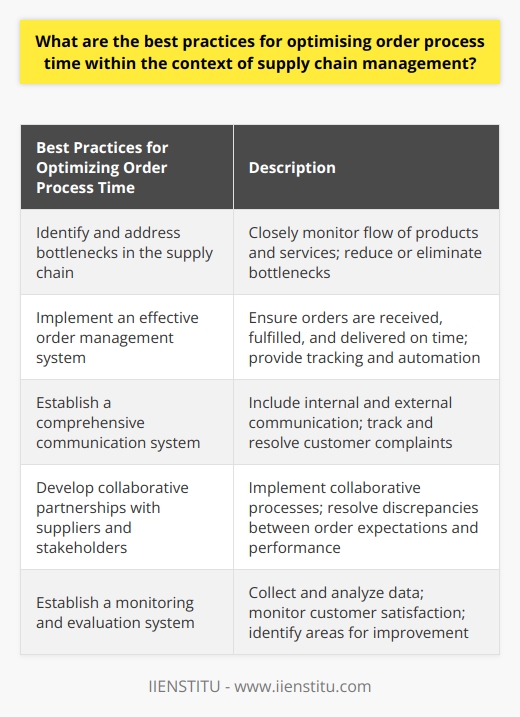
How can technology be used to improve order process time efficiency in a supply chain?
Technology can drastically reduce processing time and streamline the order cycle in a supply chain. Therefore, organizations should look to internal digital processes and external technological innovations to gain maximum efficiency from technology.
The first step in improving order processing time is to assess and identify areas within the existing systems that can be improved. For example, automation of core processes through software platforms can improve response time and accuracy within customer orders. This helps to reduce the manual processing effort associated with order entry and tracking, which can speed up the order process overall. Also, implementing robust cross-organizational communication protocols allows customer service departments and management to easily communicate with one another, reduce the time taken to process customer orders and increase customer satisfaction.
Artificial intelligence can significantly improve the accuracy of orders within a supply chain. AI-based algorithms can automatically detect any discrepancies between different departments within a supply chain and quickly resolve any such issues. This helps warehouses automate their order accuracy reviews, reducing processing time and any rework related to inaccurate orders.
In addition, utilizing related emerging technologies, such as mobile applications and automated tracking devices, can help streamline the supply chain. Such technologies enable sophisticated tracking of merchandise from the point of sale to delivery, helping to identify real-time bottlenecks and reduce order cycle times drastically. Furthermore, the use of embedded radio-frequency identification (RFID) tags can be used to enable effective traceability of merchandise, further streamlining order processing.
In conclusion, using the right upstream and downstream technologies can drastically improve order processing time within a supply chain. Automation of order entry and tracking processes and effective communication between departments can reduce the manual effort associated with filling customer orders. AI-based algorithms can help detect discrepancies quickly, and emerging technologies such as mobile applications and embedded RFID tags allow merchandise tracking effectively. Taking advantage of the right technologies at the right time can significantly improve the order process time efficiency in a supply chain.
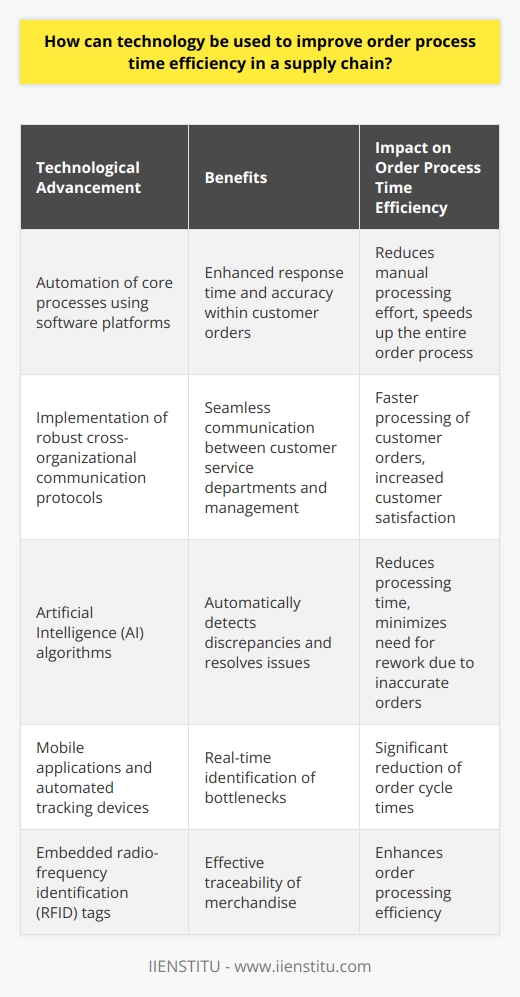
What are the advantages of optimising order process time within a supply chain environment?
Order process optimization is becoming increasingly important in meeting the demands of today’s supply chain environment, where customers expect speed and accuracy. By streamlining order processes, companies can maximize customer satisfaction while reducing costs and capitalizing on time-saving opportunities. Here are some of the advantages of order process optimization within a supply chain environment:
Faster Order Processing: Optimizing a supply chain's order process accelerates order processing and can lead to shorter lead times, lower order processing costs, and quicker order fulfillment, ultimately leading to higher customer satisfaction and loyalty. By using automated systems, companies can standardize, streamline and automate processes, improving order delivery speed and accuracy.
Improved Visibility and Inventory Management: One of the critical benefits of optimized order processing is increased visibility, enabling companies to better manage their orders, inventory, and stock. This improved visibility can help avoid stock-outs and overstocking, lowering inventory costs and decreasing overall supply chain costs.
Cost Savings: Improved efficiency leads to direct cost savings as processes that took weeks to complete can now take just a few hours and offers cost savings by reducing transactional, labor, and freight costs.
Increased Productivity: Employees become more productive by optimizing the order process. Automated systems can allow employees to focus on better decision-making and resolving problems rather than on paperwork, reducing errors and manual effort. Employees can also be given more time for higher value-added activities, such as responding to customer queries or problem-solving.
In today’s ever-changing environment, optimizing the order process is essential for any company looking to remain competitive. The advantages described above make it clear that companies that don’t take steps to optimize their order process risk falling behind the competition. Optimizing a supply chain’s order process requires an organized, holistic approach involving all stakeholders involved in the supply chain process. This approach should focus on increasing automation and incorporating technology that can provide visibility and support to optimize the order process.
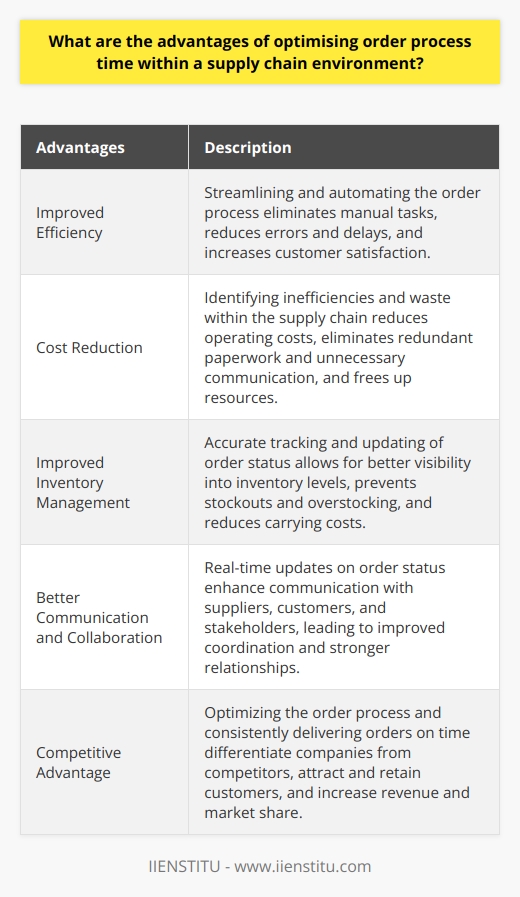
What is the key to a successful supply chain?
**Effective Coordination**
The key to a successful supply chain lies in effective coordination among various stakeholders involved in the process. This includes manufacturers, suppliers, logistics providers, and end-users, who need to work in synergy for smooth and efficient supply chain operations.
**Adopting the Right Technology**
Incorporating appropriate technology into supply chain processes enables better tracking, monitoring, and analysis of data. This, in turn, facilitates enhanced decision-making and improves the overall efficiency and effectiveness of the supply chain.
**Robust Inventory Management**
Efficient inventory management plays a vital role in streamlining supply chain processes. By accurately forecasting demand, maintaining optimal inventory levels, and minimizing stockouts or overstocks, organizations can improve customer satisfaction and reduce operational costs.
**Agile Adaptation and Flexibility**
A successful supply chain is one that can swiftly adapt and respond to fluctuating market demands and unforeseen disruptions. This requires the development of agile strategies that enable organizations to seamlessly adjust their supply chain operations in response to changing circumstances.
**Fostering Trust and Collaboration**
Building trust and fostering collaboration among supply chain partners is essential for ensuring the smooth flow of information, resources, and goods. Organizations must focus on nurturing long-term relationships with their partners by maintaining open communication channels and promoting a culture of trust and transparency.
**Sustainability and Compliance**
Finally, adhering to ethical, environmental, and regulatory standards is crucial for a successful supply chain. By adopting sustainable practices and ensuring compliance with applicable laws and regulations, organizations not only enhance their reputation but also minimize risks associated with non-compliance.
In conclusion, the key to a successful supply chain lies in striking the right balance between efficiency, agility, and sustainability by focusing on effective coordination, technology integration, robust inventory management, and strong relationships with supply chain partners. By addressing these factors and continuously improving their supply chain processes, organizations can stay competitive and meet the evolving needs of their customers.

How do you optimize the supply chain process?
Supply Chain Visibility
Optimizing the supply chain process involves incorporating supply chain visibility through technology and communication. Companies should implement digital solutions such as real-time data monitoring and analytics to assess their supply chain's performance. This enables faster decision-making and quicker reactions to potential disruptions.
Agile Adaptation
An agile adaptation strategy promotes responsiveness and flexibility to cope with unforeseen changes in demand and supply. By adopting a lean supply chain approach, businesses can minimize inventory management costs and reduce lead times. Incorporating dynamic planning into sourcing, manufacturing, and distribution operations allows companies to adapt to changes more efficiently.
Collaboration and Integration
Effective supply chain optimization requires strong collaboration and integration between all stakeholders. This involves practices like sharing key performance indicators (KPIs), streamlining communication channels, and developing partnerships with vendors and suppliers. Such integrative efforts can lead to synchronized operations and mutual goals among all supply chain participants, ultimately increasing efficiency.
Sustainability and Risk Management
Optimizing the supply chain process should also involve addressing environmental and social issues. By implementing sustainable practices such as reducing waste, promoting recycling, and optimizing transportation routes, companies can lessen their environmental impact and bolster their reputation. Additionally, robust risk management strategies should be in place, including regular audits and contingency plans, to ensure a resilient supply chain.
Continuous Improvement
Supply chain optimization is an ongoing process that calls for continuous improvement. Regular assessments of supply chain performance allow companies to identify areas of inefficiency and implement necessary adjustments. The adoption of advanced technology solutions, embracing innovation, and a commitment to learning from best practices can all contribute to consistent improvements in supply chain performance.

What are the 5 basic steps of supply chain management?
**Planning and Forecasting**
The first basic step of supply chain management is planning and forecasting. In this stage, organizations determine the demand for products and services, and plan accordingly. This involves analyzing historical data, market trends, competition, and customer requirements to create an accurate forecast.
**Sourcing and Procurement**
Sourcing and procurement are the next crucial steps in supply chain management. Here, companies identify potential suppliers, evaluate their capabilities, and select the most appropriate ones. This process involves negotiating contracts, specifying terms and conditions, and establishing a strong relationship with suppliers to ensure a steady flow of goods.
**Manufacturing and Production**
In the manufacturing and production stage, companies transform raw materials into finished products or services. This involves coordinating with suppliers, monitoring quality, managing production schedules, and ensuring timely delivery. Organizations employ lean manufacturing techniques and continuous improvement strategies to optimize this process, aiming for efficiency and cost reduction.
**Warehousing and Inventory Management**
Once production is completed, warehousing and inventory management come into play. This stage involves storing, tracking, and managing finished goods in an organized manner. Companies use various inventory control methods, such as just-in-time and safety stock, to minimize carrying costs and obsolescence while ensuring product availability for customers.
**Logistics and Distribution**
The final step in supply chain management is logistics and distribution. At this stage, companies coordinate the movement of products from manufacturing facilities to end-users. This involves selecting appropriate transportation modes, managing relationships with carriers, and monitoring shipments to ensure timely and efficient delivery. Furthermore, companies must process customer orders effectively and manage returns and exchanges when necessary.
In conclusion, the five basic steps of supply chain management are planning and forecasting, sourcing and procurement, manufacturing and production, warehousing and inventory management, and logistics and distribution. Each step is vital in ensuring that organizations can meet customers' demands while maintaining a competitive edge in the market.
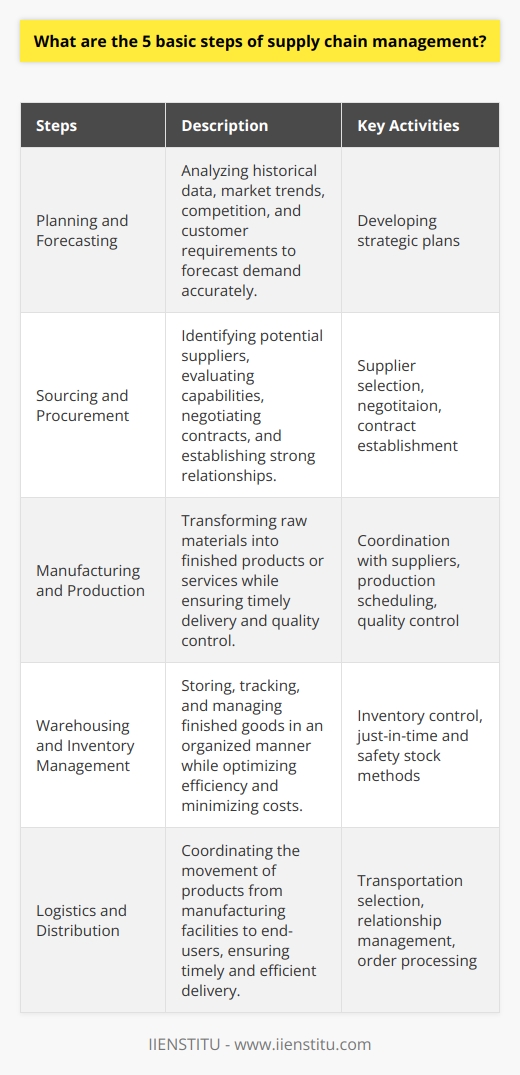
What is optimization in supply chain management?
Optimization in Supply Chain Management
Defining the Concept
Optimization in supply chain management refers to the process of improving various aspects of a company's supply chain. Specifically, it involves maximizing profits, minimizing costs, and enhancing customer satisfaction by making strategic decisions about sourcing, production, distribution, and inventory management.
Objectives and Applications
Supply chain optimization aims to improve a company's competitiveness and responsiveness to market trends. It enables organizations to streamline their operations, reduce lead times, and better meet customer demands. This is achieved through various methods such as forecasting, data analysis, and technological innovations.
Efficient Resource Allocation
One key aspect of optimization in supply chain management is efficient resource allocation. This involves determining the most cost-effective ways to allocate resources for sourcing raw materials, production processes, and transportation of goods. By optimizing resource allocation, companies can reduce operational costs, improve the performance of their supply chain, and increase profits.
Effective Inventory Management
Another critical aspect of supply chain optimization is effective inventory management. To ensure customer satisfaction and avoid stockouts or overstocking, organizations need to maintain optimal inventory levels. Advanced inventory management techniques, such as just-in-time production and demand planning, can help companies achieve these goals while minimizing costs.
Advanced Technologies and Tools
In recent years, advanced technologies and tools have played a significant role in supply chain optimization. The implementation of predictive analytics, artificial intelligence, and machine learning enables companies to make more informed decisions relating to production, transportation, and inventory management. By leveraging these technologies, organizations can maximize efficiency, responsiveness, and cost savings across their supply chains.
Overcoming Challenges
While there are numerous advantages to supply chain optimization, organizations often face challenges when implementing it. These may include data quality issues, resistance to change, and resource constraints. By carefully planning and adopting a long-term approach, companies can overcome these challenges and reap the benefits of optimization in supply chain management.
In conclusion, optimization in supply chain management encompasses a wide range of techniques, tools, and strategies aimed at improving the efficiency, cost-effectiveness, and responsiveness of an organization's supply chain. Through better resource allocation, inventory management, and technology adoption, companies can achieve optimization goals and enjoy a competitive advantage in the marketplace.
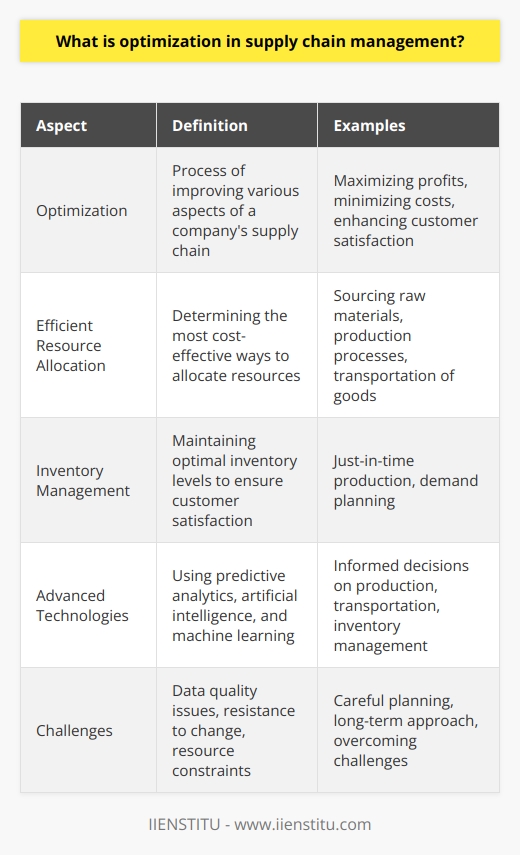
What role does communication play in ensuring a successful supply chain?
Role of Communication in Supply Chain Success
Effectiveness of Coordination
Communication plays a crucial role in ensuring a successful supply chain by enhancing the effectiveness of coordination among various stakeholders. Clear and timely communication allows supply chain partners to share crucial information, such as inventory levels, production schedules, and demand forecasts. This enables them to make informed decisions, minimize uncertainties, and reduce the possibility of stockouts or excess inventory.
Streamlined Vendor Relations
Effective communication also streamlines vendor relations and collaboration. By communicating openly and honestly with vendors, companies can negotiate better contracts, ensure timely delivery of products, and resolve any issues or discrepancies that may arise. Furthermore, developing strong relationships with vendors through effective communication can lead to improved supplier performance, increased trust, and mutual growth.
Enhanced Customer Satisfaction
Customer satisfaction is paramount to supply chain success, and communication plays a pivotal role in achieving it. Providing customers with accurate information about product availability, shipping times, and delivery expectations helps manage their expectations and enhances the overall customer experience. Moreover, maintaining open lines of communication with customers allows companies to understand their needs, customize their offerings, and resolve any issues that may arise after the sale.
Efficient Problem-Solving
Open communication channels facilitate efficient problem-solving within a supply chain, allowing all parties to identify potential issues and develop solutions proactively. By sharing information and concerns regularly, supply chain actors can work together to optimize processes, avoid potential bottlenecks, and troubleshoot any breakdowns in the supply chain network. This collaboration not only mitigates risks but also promotes flexibility and agility, essential attributes in today's ever-evolving business landscape.
In conclusion, communication is a key driver of supply chain success, as it enables effective coordination among stakeholders, streamlines vendor relations, enhances customer satisfaction, and ensures efficient problem-solving. A supply chain that invests in building robust communication channels and fostering open dialogue among its partners will likely yield better results in terms of efficiency, cost-effectiveness, and overall performance.
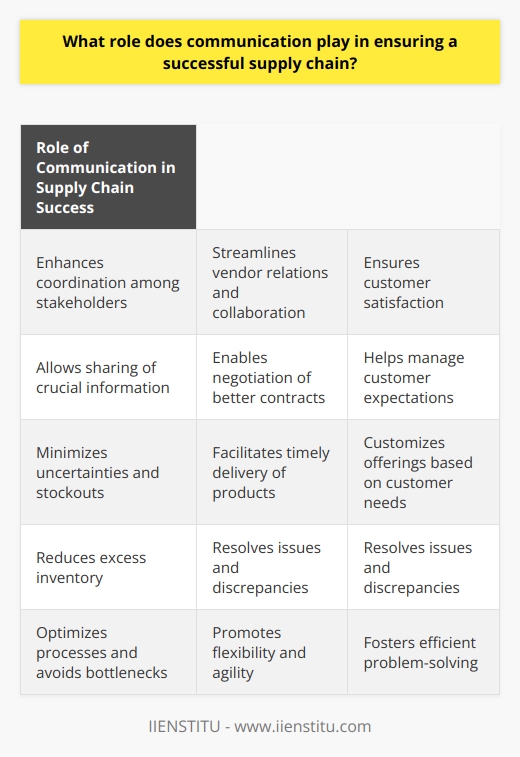
How does integration of various processes contribute to supply chain management optimization?
Integration of Processes in Supply Chain Management
The integration of various processes in supply chain management (SCM) plays a critical role in its optimization. Effective communication, technology utilization, and collaboration among stakeholders can directly impact the overall performance of the supply chain.
Enhancing Communication and Information Sharing
One way integration contributes to SCM optimization is by facilitating better communication and information sharing among parties involved. Integrating processes such as procurement, manufacturing, and distribution ensures timely exchange of information, leading to reduced lead times, improved inventory management, and cost savings.
Leveraging Technological Advancements
Technological advancements, such as the use of enterprise resource planning (ERP) systems or electronic data interchange (EDI), ensure easy access to real-time data from different processes in the supply chain. By integrating these processes using technology, companies can streamline their operations, reduce redundancies, and enhance their decision-making capabilities.
Collaborative Approach and Partnerships
Integration also fosters collaboration among supply chain partners, enabling them to work as a single entity with shared goals and objectives. Collaborative partnerships lead to better resource utilization, reduced uncertainties, and risk mitigation across the entire supply chain.
Enhancing Forecast Accuracy and Demand Planning
A well-integrated supply chain improves the accuracy of demand forecasts by pooling data from various processes, leading to better anticipation of customer needs. This results in fewer stockouts, less overstock, and increased responsiveness to market demands, all of which contribute to overall optimization.
Reducing Costs and Streamlining Operations
By enabling transparency between partners and centralizing decision-making, integration minimizes the overall operational costs associated with inventory management, transportation, and warehousing. It also ensures that resources are efficiently utilized, minimizing waste and redundancies.
In conclusion, the integration of various processes in supply chain management plays a vital role in enhancing communication, leveraging technology, fostering collaboration, improving demand planning, and reducing costs for the overall optimization of the supply chain. Companies should invest in both technology and human capital to reap the benefits of a well-integrated supply chain management system.
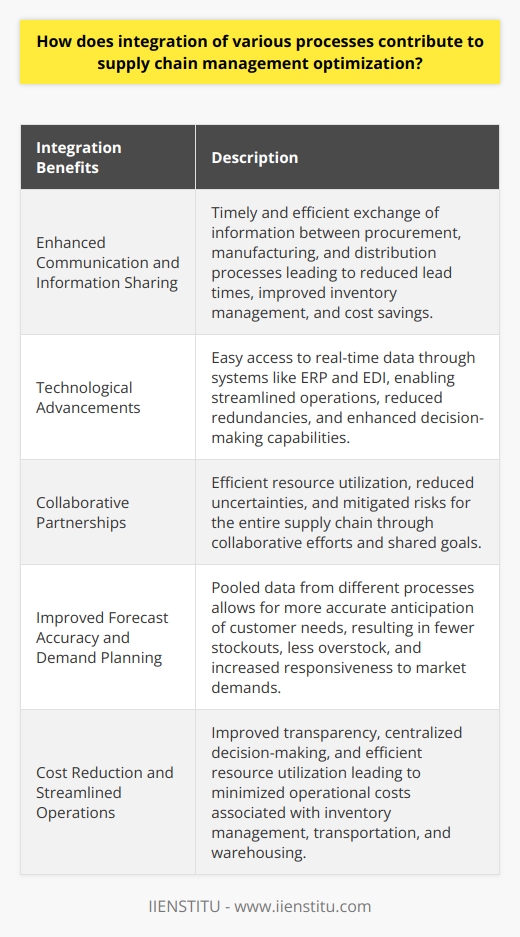
What is the role of strategic sourcing in optimizing supply chain management?
Role of Strategic Sourcing in Supply Chain Optimization
Significance of Strategic Sourcing
Strategic sourcing plays a pivotal role in optimizing supply chain management by enabling companies to procure materials and services at the right price, time, and quality. By forming a comprehensive procurement strategy, it helps companies reduce overall costs, strengthen supplier partnerships, and mitigate supply chain risks.
Cost Reduction Opportunities
Introducing a strategic sourcing approach helps supply chain professionals identify and capitalize on opportunities for cost reduction. It offers businesses effective methods to consolidate supplier bases, negotiate better contracts, and leverage economies of scale, ultimately resulting in operational efficiencies and cost savings throughout the supply chain.
Enhanced Supplier Relationships
Strategic sourcing promotes collaboration and fosters closer relationships with key suppliers. By engaging in continuous improvement initiatives and maintaining open lines of communication, businesses can build long-lasting partnerships. This approach encourages mutual growth, strengthens supply chain resilience and ensures the consistent delivery of high-quality materials and services.
Risk Mitigation Tactics
Supply chain volatility exposes businesses to potential risks, including fluctuating prices, lead time delays, and supplier performance issues. Strategic sourcing aims to mitigate these risks by providing data-driven insights into supplier selection and evaluation, allowing companies to diversify their supplier bases, promote transparency and implement contingency plans to minimize disruption.
Third-Party Integrations
The role of strategic sourcing also extends to third-party service providers, such as consulting firms, procurement technologies, and logistics providers. By integrating these services into the procurement strategy, businesses can effectively streamline their supply chain processes and manage overall costs.
In conclusion, strategic sourcing is a critical success factor for optimizing supply chain management. Its focus on cost reduction, supplier relationships, risk mitigation, and third-party integrations contribute to a more efficient and resilient supply chain. By adopting strategic sourcing practices, companies can achieve a competitive advantage in the market while delivering value to their customers.
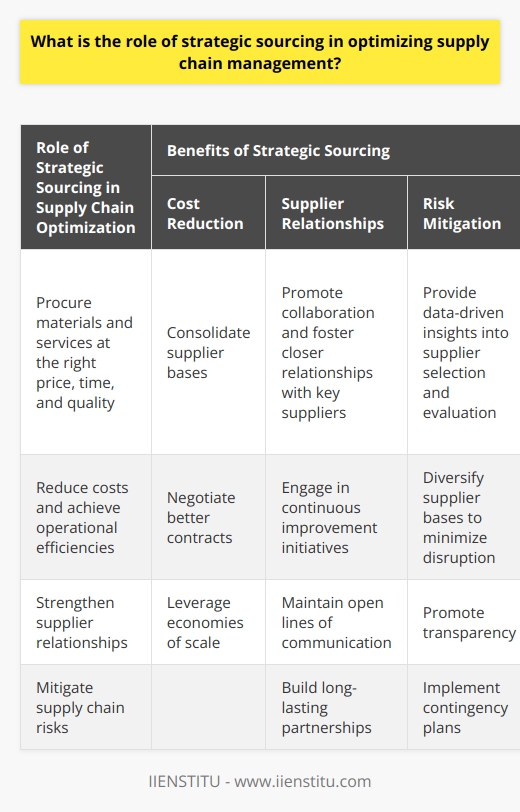
How does forecasting accuracy impact supply chain optimization?
Forecasting Accuracy's Role in Supply Chain Optimization
Significance of Accurate Forecasts
Accurate forecasting plays a crucial role in supply chain optimization as it helps businesses make informed decisions about production, inventory, and distribution. It enables companies to anticipate changes in demand and supply, giving them a competitive edge by preparing for future market trends. Moreover, accurate forecasting helps reduce uncertainty, leading to improved performance and increased efficiency within the supply chain.
Improved Production Planning
One primary outcome of accurate forecasting is enhanced production planning. By having reliable estimations of customer demand, businesses can schedule their manufacturing processes more effectively. They can ensure the right amount of resources, labor, and materials are available for production, thereby minimizing overstocking, reducing waste, and avoiding stockouts. Consequently, accurate forecasting enables companies to adapt their production strategies to meet changing market conditions while maximizing the utilization of resources and minimizing costs.
Efficient Inventory Management
Accurate forecasting also has a direct impact on inventory management. With precise predictions of future demand, companies can maintain an optimal level of inventory to fulfill customer orders without overstocking or understocking. This balance enables businesses to reduce holding costs, minimize stockouts, and optimize warehousing space. Additionally, accurate forecasting supports better coordination between suppliers and retailers, further contributing to streamlined inventory management practices.
Effective Distribution Strategy
Lastly, by enhancing forecasting accuracy, companies can optimize their distribution strategies. Accurate demand forecasts allow businesses to allocate resources efficiently across their distribution networks, ensuring the right products are delivered to the right location at the right time. This synchronization helps minimize costs related to transportation, storage, and handling, ultimately leading to improved customer service and increased customer satisfaction.
In conclusion, accurate forecasting is a critical component of supply chain optimization as it enables businesses to make informed decisions about production, inventory, and distribution. By improving forecasting accuracy, companies can enhance production planning, streamline inventory management, and develop more effective distribution strategies. This leads to reduced uncertainty, increased efficiency, and ultimately a more competitive and robust supply chain.
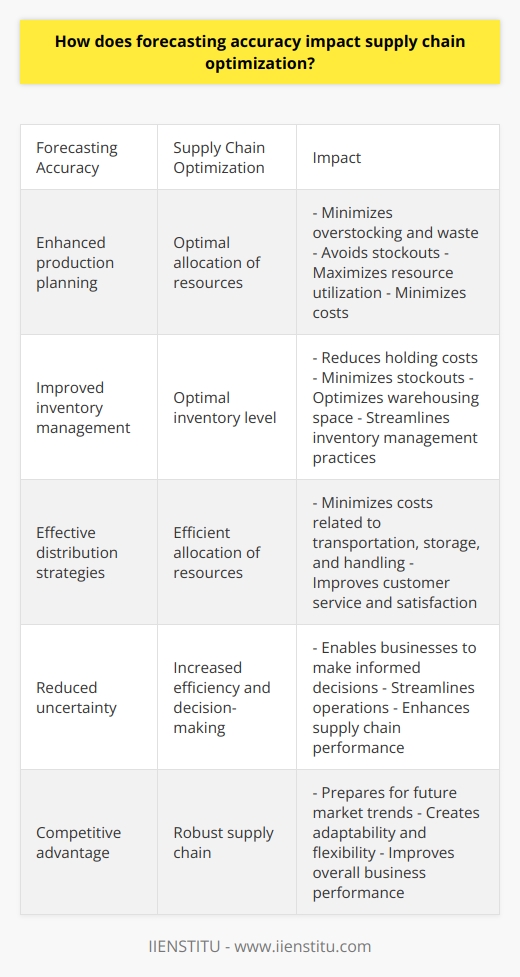
In what ways can sustainability initiatives contribute to supply chain management optimization?
Sustainable Practices Enhancing SCM
Sustainability initiatives can significantly contribute to supply chain management (SCM) optimization in various ways. By integrating environmentally responsible practices, businesses can positively impact cost reduction, risk management, and customer relations.
Cost Reduction through Efficient Resource Use
Sustainable supply chain practices can lead to cost savings by minimizing waste and promoting efficient use of resources. Companies can identify opportunities for reducing energy consumption, optimizing packaging, and implementing recycling initiatives, which contribute to a leaner, more cost-effective supply chain. Moreover, by reducing their environmental footprint, businesses can take advantage of government incentives and better negotiate favorable contracts with suppliers.
Risk Management through Transparency and Traceability
Sustainability initiatives entail increasing the transparency and traceability of the supply chain. By tracking the sources and impacts of materials and products, companies can proactively identify potential risks stemming from regulatory requirements and public scrutiny. Additionally, companies that demonstrate strong ethical and environmental commitments can mitigate risks associated with brand reputation and customer loyalty, ensuring continued market success.
Customer Relations through Sustainable Product Offerings
Consumer demand for sustainable products is on the rise, as evidenced by the growing segment of environmentally conscious shoppers. By incorporating sustainability initiatives in SCM, businesses can cater to this market segment and strengthen customer relations. Offering products made from eco-friendly materials or using ethical labor practices can enhance brand image and increase customer loyalty to sustain long-term growth.
Collaboration for Innovative Solutions
Finally, sustainability initiatives can fuel innovation and foster collaboration among supply chain partners. By working together to achieve shared sustainability objectives, companies may uncover novel ideas and solutions for improving supply chain efficiency, reducing costs, and addressing environmental and ethical concerns. This collaborative approach can lead to a competitive advantage for all involved, resulting in optimized supply chain management.
In conclusion, incorporating sustainability initiatives into supply chain management can significantly contribute to optimization by reducing costs, managing risks, enhancing customer relations, and stimulating collaboration and innovation. By adopting such practices, businesses can not only navigate the complex landscape of environmental and ethical concerns but also achieve more efficient and resilient supply chain operations.
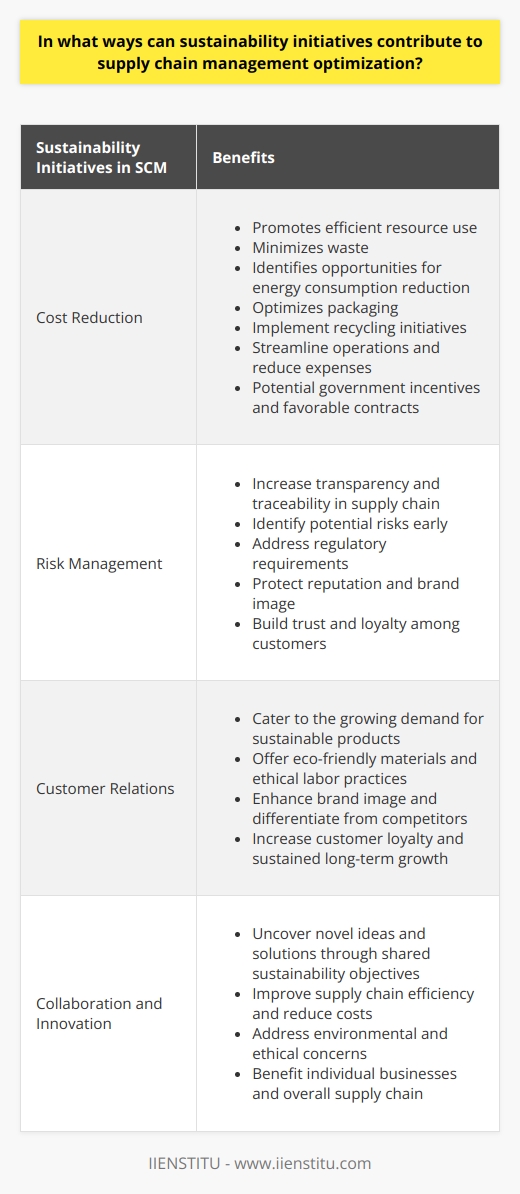
What does optimization mean in supply chain?
Significance of Optimization in Supply Chain
In the context of supply chain management, optimization refers to the process of systematically regulating and refining operational activities and management decisions to enhance efficiency, effectiveness, and overall performance of the supply chain. This continuous improvement approach aims to strike a balance between competing objectives such as cost minimization, customer satisfaction, and operational resilience.
Different Aspects of Supply Chain Optimization
Inventory Management: Optimization involves determining the appropriate inventory levels to maintain at each stage of the supply chain, considering factors such as demand variability, lead times, and carrying costs. Efficient inventory management helps minimize stock-outs, overstocks, and obsolescence costs while ensuring product availability.
Transportation and Logistics: Optimization in this area entails selecting the most effective transportation modes, routes, and carriers to facilitate the flow of goods from suppliers to customers. It requires a thorough analysis of trade-offs between transportation costs, lead times, and service quality.
Network Design: This aspect of optimization involves determining the optimal number, location, and capacity of manufacturing plants, distribution centers, and other supply chain nodes. It requires considering factors such as transportation costs, demand patterns, and tax implications for an efficient and resilient supply chain structure.
Supplier Management: Optimization in supplier management involves identifying, evaluating, and selecting suppliers that offer the best combination of price, quality, delivery, and innovation to support the organization's objectives. Effective supplier management reduces risks, strengthens partnerships, and fosters a collaborative environment between supply chain partners.
Demand Forecasting: Accurate demand forecasting is critical for optimizing supply chain performance. It enables organizations to anticipate fluctuations in demand, adjust production schedules and inventory levels accordingly, and align supply chain activities to fulfill customer requirements timely and cost-efficiently.
Information Technology: The use of advanced information systems and data-driven analytics tools is essential in the optimization process. These technologies enable supply chain managers to access real-time information, analyze trends, and make data-driven decisions, ultimately enhancing supply chain performance and competitiveness.
In conclusion, optimization in supply chain management is a vital process, resulting in enhanced operational efficiency, cost reductions, and improved customer satisfaction. By strategically addressing various aspects such as inventory, transportation, network design, supplier management, and demand forecasting, organizations can optimize their supply chains to drive competitive advantage and sustainable growth.
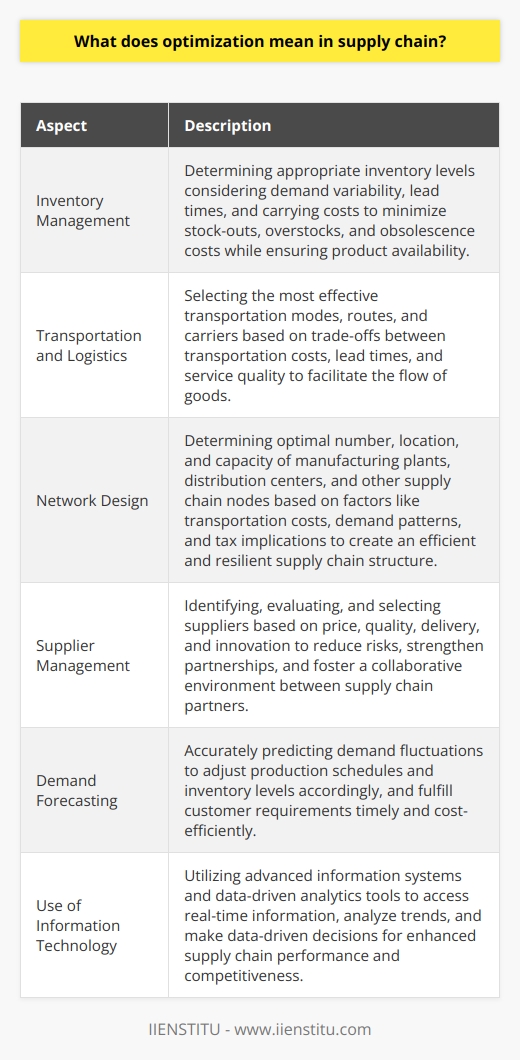
How can efficient inventory management contribute to supply chain optimization?
Efficient Inventory Management Techniques
Efficient inventory management is crucial for supply chain optimization, as it allows companies to maintain an appropriate level of inventory while minimizing costs and meeting customer demand. By effectively managing inventory levels, companies can reduce warehousing expenses, prevent stockouts or overstock situations, and streamline overall supply chain operations.
Demand Forecasting and Planning
A critical component of efficient inventory management is accurate demand forecasting and planning. By analyzing historical data, companies can predict future demand, allowing for more precise inventory management. This optimization helps to prevent stockouts, which can lead to lost sales and customer dissatisfaction, as well as reduce excess inventory, which requires additional storage costs and may become obsolete over time.
Just-In-Time Inventory Control
The Just-In-Time (JIT) inventory control method is another effective technique for supply chain optimization. By implementing JIT, companies can reduce or eliminate inventory by ordering and receiving goods only when they are needed for production or sales. This approach not only lowers storage and holding costs but also minimizes the risk of inventory obsolescence or spoilage.
Vendor Managed Inventory
Another way to optimize the supply chain is through Vendor Managed Inventory (VMI), wherein suppliers are responsible for managing inventory levels at the customer's location. VMI enables closer collaboration between suppliers and customers, leading to improved forecasting and inventory management. This partnership ultimately reduces the risk of stockouts and overstock situations, resulting in a more efficient supply chain.
Continuous Improvement and Technology
Continuous improvement is essential for supply chain optimization, and efficient inventory management plays a significant role in this process. By regularly evaluating and refining inventory management strategies, companies can identify and eliminate bottlenecks or inefficiencies in the system. Furthermore, the incorporation of advanced technologies, like Enterprise Resource Planning (ERP) systems and warehouse automation, can significantly improve inventory management processes, contributing to supply chain optimization.
In conclusion, efficient inventory management is a vital factor in optimizing the supply chain for businesses. By implementing techniques such as demand forecasting, JIT inventory control, VMI, and continuous improvement, companies can minimize costs, maximize customer satisfaction, and streamline overall supply chain operations.
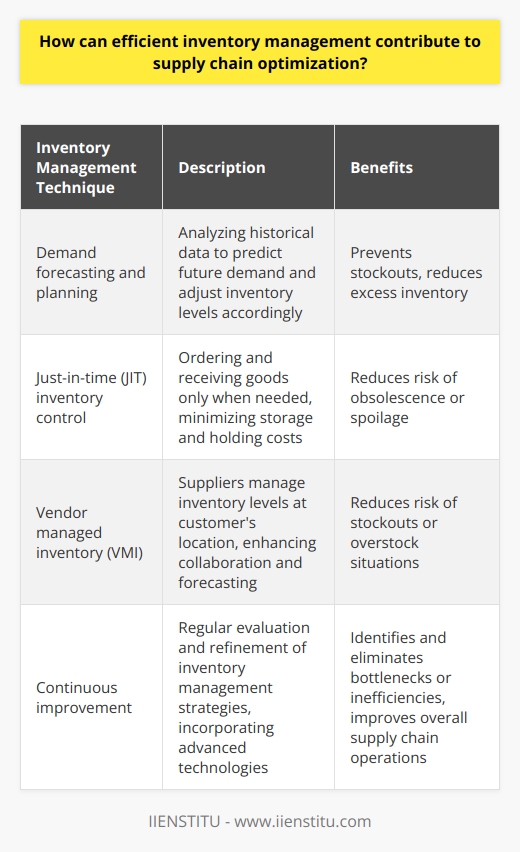
What role does data analysis play in enhancing supply chain performance and optimization?
Role of Data Analysis in Performance Enhancement
Data analysis significantly contributes to enhancing supply chain performance by enabling organizations to make well-informed decisions. Through the collection, processing, and interpretation of extensive datasets, businesses can identify trends and patterns that help them understand customer behavior, optimize inventory levels, and streamline logistics processes.
Customer Demand Forecasting
A crucial aspect of supply chain optimization involves forecasting customer demand, which requires accurate and timely data analysis. By examining historical sales data, seasonal trends, and market conditions, organizations can predict future demand for their products, allowing them to adjust their production schedules, inventory levels, and resource allocation to meet anticipated needs.
Inventory Management and Optimization
Effective inventory management is a vital component of a high-performing supply chain. Data analysis facilitates the control and optimization of inventory levels by identifying optimal stock levels, replenishment schedules, and safety buffers. Moreover, analyzing inventory data enables businesses to minimize excess and obsolete inventory, reduce holding costs, and prevent stockouts that may lead to lost sales and customer dissatisfaction.
Logistics and Distribution Efficiencies
Data analysis plays an essential role in optimizing logistics and distribution processes, ensuring that products are delivered efficiently and cost-effectively. By assessing transportation modes, shipping routes, carrier performance, and other logistical factors, organizations can design distribution networks that minimize costs, reduce transit times, and improve quality and service levels. Furthermore, the integration of real-time data enables businesses to monitor their supply chain's performance and respond to disruptions or changes in demand rapidly.
Supplier Performance Evaluation
Supply chain performance is directly affected by the interaction with suppliers. Data-driven evaluation of supplier performance helps businesses identify areas of improvement, streamline communication, and minimize potential risks. By tracking key performance indicators (KPIs), such as on-time delivery, quality metrics, and order fulfillment rates, organizations can ensure their suppliers are meeting expectations and contributing to overall supply chain efficiency.
In conclusion, data analysis is an invaluable tool for supply chain performance enhancement and optimization. Through accurate forecasting, streamlined inventory management, efficient logistics and distribution processes, and effective supplier performance evaluation, organizations can leverage data-driven insights to achieve a competitive advantage in today's ever-evolving business landscape.
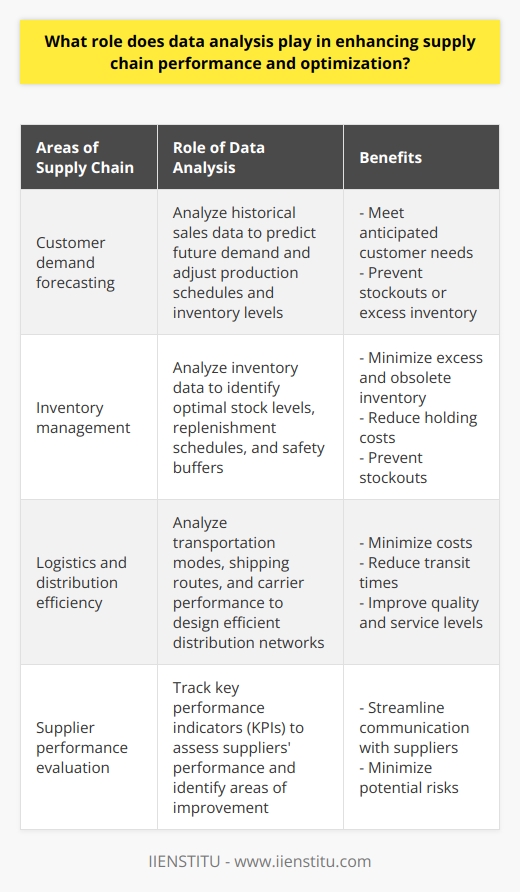
What are the critical factors to consider when implementing a supply chain risk management strategy?
Assessing Supply Chain Vulnerability
First and foremost, organizations must assess vulnerabilities in their supply chains in order to identify potential risks. By scrutinizing suppliers' financial health, geographical location, and organizational structure, companies can detect weak links and work toward strengthening them.
Establishing Risk Appetite
Organizations need to establish their risk appetite by determining the level of risk they are willing to accept. This enables them to prioritize critical elements in their supply chain, allocate resources accordingly, and implement appropriate risk mitigation measures.
Building Supply Chain Resilience
Resilience is paramount when managing supply chain risks. Companies can achieve this by diversifying supplier bases, maintaining appropriate inventory levels, and investing in robust technologies. A resilient supply chain allows organizations to recover quickly from disruptions, ultimately minimizing negative impacts on their operations.
Implementing Continuous Monitoring
Continuous monitoring of supply chain activities is essential for maintaining a comprehensive risk management strategy. This involves tracking key performance indicators, conducting regular audits, and utilizing real-time data to identify emerging risks. By staying informed about potential disruptions, organizations can proactively address issues and limit potential damage.
Risk Sharing and Collaboration
Effective risk management requires collaboration among stakeholders, including suppliers, customers, and other partners. By forging strong relationships, organizations can create synergies, share valuable information, and jointly develop mitigation strategies. Moreover, risk sharing arrangements, such as insurance or performance-based contracts, can help distribute the financial burden of potential supply chain disruptions.
Developing a Contingency Plan
Finally, a strategic contingency plan is critical for addressing unforeseen disruptions in the supply chain. This plan should include clearly defined roles and responsibilities, procedures for rapid response, and thresholds for activating recovery measures. By having an established contingency plan, companies can mitigate the effects of unexpected risks, ensuring a more efficient recovery process.
In conclusion, the critical factors to consider when implementing a supply chain risk management strategy include vulnerability assessment, risk appetite determination, resilience building, continuous monitoring, stakeholder collaboration, and contingency planning. By addressing these factors, organizations can minimize the impact of disruptions on their operations and maintain a competitive edge in today's dynamic business environment.
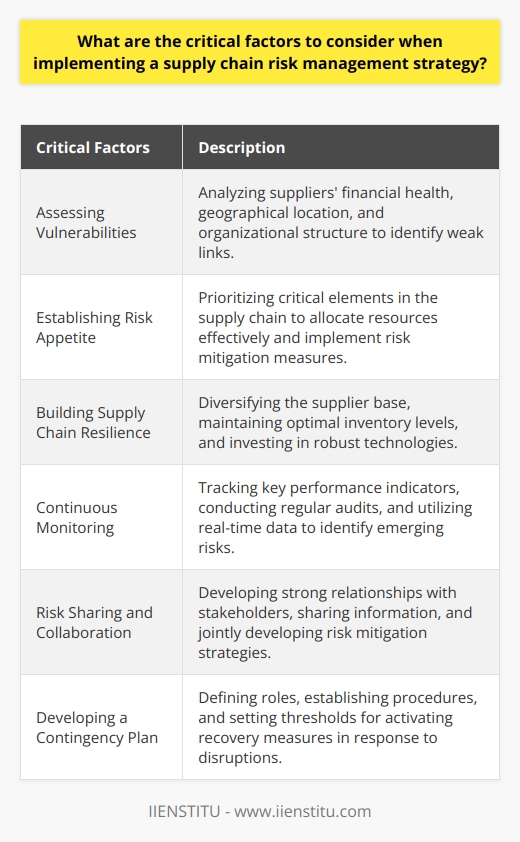
How do demand planning and forecasting contribute to supply chain optimization?
Demand Planning and Forecasting: Key Components for Optimization
Effectively managing supply chains is a critical goal for businesses, and demand planning and forecasting play pivotal roles in achieving this objective. These processes enable companies to make better decisions on various aspects such as procurement, production, inventory management, and distribution, ultimately leading to supply chain optimization.
Accurate Demand Estimation
One of the central benefits of demand planning and forecasting is the accurate estimation of customer demand. With a clear understanding of current and future market needs, businesses can align their supply chain processes accordingly. This reduces the likelihood of stockouts and overstock situations, improving customer satisfaction and reducing inventory holding costs.
Maintaining Optimal Inventory Levels
As demand planning and forecasting involves determining the right amount of products to keep in stock, businesses can maintain optimal inventory levels. This equilibrium ensures that companies meet customer expectations without tying up excessive capital in unused inventory. In turn, this reduces warehousing costs and makes the supply chain more cost-effective.
Coordinated Production and Procurement
Demand planning and forecasting also contribute to supply chain optimization by facilitating coordinated production and procurement processes. By accurately predicting future demand, businesses can adjust production schedules and procurement activities to avoid inefficiencies and bottlenecks. This seamless coordination enables companies to satisfy customer requirements while minimizing waste and maximizing resource utilization.
Improved Supplier Relationships
A well-executed demand planning and forecasting process improves communication between businesses and their suppliers. Sharing demand forecasts and collaborating on procurement plans ultimately lead to stronger supplier relationships. This mutual understanding and trust translate into a more efficient and effective supply chain.
Increased Agility and Responsiveness
Finally, demand planning and forecasting allow businesses to develop a more agile and responsive supply chain. By continually monitoring demand and adjusting supply chain activities to meet fluctuations, businesses can better respond to market changes and uncertainties. This heightened adaptability provides a distinct competitive advantage in today's rapidly changing global marketplace.
In conclusion, demand planning and forecasting are indispensable for supply chain optimization. By accurately estimating customer needs, maintaining optimal inventory levels, coordinating production and procurement, improving supplier relationships, and increasing agility and responsiveness, businesses can enhance their overall supply chain performance and create a competitive edge.
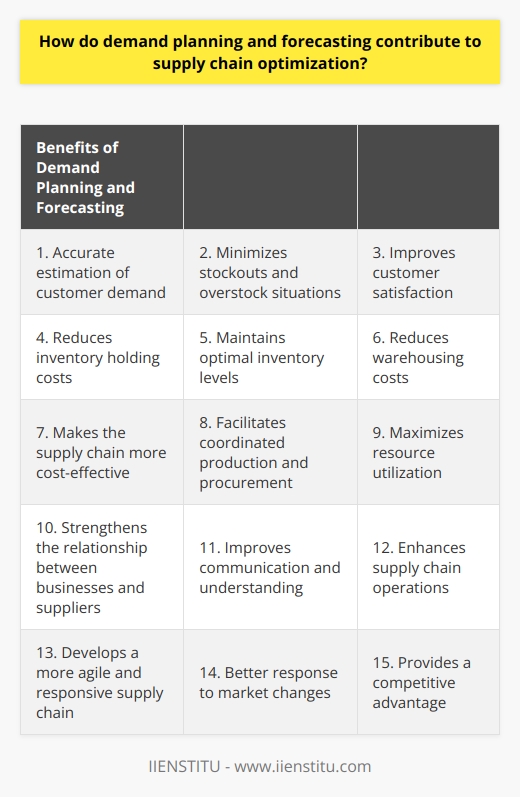
How can collaboration between suppliers, manufacturers, and customers enhance the overall supply chain performance?
Subheading: Importance of Collaboration in Supply Chain
Collaboration between suppliers, manufacturers, and customers plays a critical role in enhancing overall supply chain performance. By fostering an environment of open communication and cooperation, businesses can better align their objectives, resolve potential bottlenecks, and improve responsiveness to market demands.
Subheading: Streamlining Processes and Reducing Lead Times
A key aspect of collaboration involves streamlining processes and reducing lead times. Suppliers and manufacturers can work together to optimize production plans, minimize inventory levels, and enhance product quality. At the same time, customers can provide valuable feedback on product specifications and lead time expectations, enabling supply chain partners to make data-driven decisions and prioritize their efforts accordingly.
Subheading: Promoting Information Sharing and Transparency
Effective communication and transparency can greatly improve supply chain performance. By freely sharing information about demand forecasts, production schedules, and inventory levels, businesses can develop a shared understanding of market dynamics and coordinate their activities more efficiently. This enables them to better anticipate shifts in demand and allocate resources accordingly, thus maximizing profitability and minimizing waste.
Subheading: Encouraging Innovation and Continuous Improvement
Collaboration can also foster innovation and continuous improvement within the supply chain. Suppliers can work closely with manufacturers to develop new materials, technologies, and production methods, while customers can contribute insights on emerging trends and evolving preferences. This continuous exchange of ideas can spur product development and contribute to a more agile, responsive supply chain.
Subheading: Building Long-term, Mutually Beneficial Relationships
Lastly, collaboration helps to build long-term, mutually beneficial relationships between supply chain partners. By working together to achieve common goals, businesses can develop a sense of trust and commitment that deepens over time. This fosters loyalty and stability, ensuring that all parties are equipped to navigate the challenges and uncertainties of today's global market.
In conclusion, the collaboration between suppliers, manufacturers, and customers can greatly enhance the overall performance of supply chains. By streamlining processes, promoting information sharing, fostering innovation, and building long-term partnerships, businesses can create a more agile, responsive, and efficient supply chain system that delivers tangible benefits for all stakeholders.
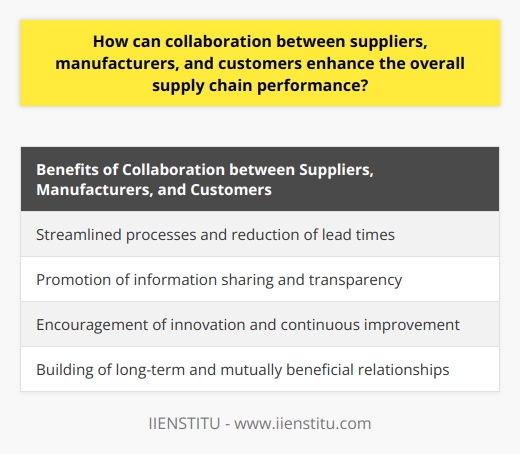
What is process optimization in supply chain management?
Components of Process Optimization in SCM
Process optimization in supply chain management (SCM) involves identifying and implementing improvements to various processes within the supply chain. These enhancements lead to increased efficiency, reduced waste, and lower costs. This crucial strategy enables businesses to respond effectively to market fluctuations while maintaining profitability.
Data Analysis and Forecasting
A key aspect of process optimization is the analysis of historical and real-time data. This information can inform demand forecasting and inventory management. Accurate demand forecasts enable companies to plan procurement, production, and distribution schedules more effectively, preventing stockouts and excess inventory.
Supplier Relationship Management
Establishing strong supplier relationships can enhance supply chain performance. This involves continuous communication, collaboration, and monitoring of supplier activities. By fostering trust and transparency, companies can negotiate better terms, reduce lead times, and minimize the risk of disruptions.
Inventory Management
Efficient inventory management is critical to process optimization. Companies must strike a balance between carrying too much or too little stock. Achieving this balance entails monitoring stock levels, tracking consumption patterns, and using data-driven decision-making to maintain optimum inventory levels.
Advanced Technologies in SCM
Implementing advanced technologies, like enterprise resource planning (ERP) systems, warehouse management systems (WMS), and radiofrequency identification (RFID), can streamline processes and improve communication across the supply chain. These technologies facilitate real-time data sharing, enhance visibility, and enable companies to monitor and adjust their processes proactively.
Continuous Improvement
Process optimization is an ongoing effort, requiring constant monitoring and improvement. Companies should conduct regular assessments of their supply chain processes and identify areas of inefficiency or waste. By implementing targeted improvement initiatives, businesses can ensure their supply chain continually adapts and remains competitive in the market.
In conclusion, process optimization in SCM is a multifaceted strategy that aims to enhance efficiency, reduce costs, and improve the overall performance of a supply chain. Through data analysis, supplier relationship management, inventory management, implementation of advanced technologies, and commitment to continuous improvement, businesses can optimize their processes and maintain a competitive edge in the market.

What are the 3 key points of supply chain management?
**Effective Coordination**
One key point of supply chain management (SCM) is effective coordination among various entities involved in the supply chain. SCM aims to synchronize procurement, production, and distribution processes so that raw materials, intermediate products, and finished goods are at the right place at the right time. Effective coordination requires strong communication and collaboration among participating organizations, including suppliers, manufacturers, wholesalers, and retailers.
**Risk Management**
Another crucial element of SCM is risk management. Supply chain risks arise from a variety of sources, including supplier insolvency, production disruptions, transportation delays, and fluctuating market demand. To minimize the potential negative impacts of these uncertainties, supply chain managers employ a range of strategies, such as diversifying suppliers, maintaining safety stock, and implementing early warning systems. By proactively identifying and addressing potential threats, SCM contributes to building a resilient and flexible supply chain that can withstand unexpected disruptions.
**Cost Optimization**
Lastly, a primary objective of supply chain management is cost optimization. This involves the continuous examination and improvement of supply chain operations to reduce expenses and maximize overall value. Cost-effective strategies may include negotiating better agreements with suppliers, streamlining transportation and warehousing practices, and adopting lean manufacturing principles. These efforts help organizations achieve higher profits, increase efficiency, and maintain a competitive advantage in the market.
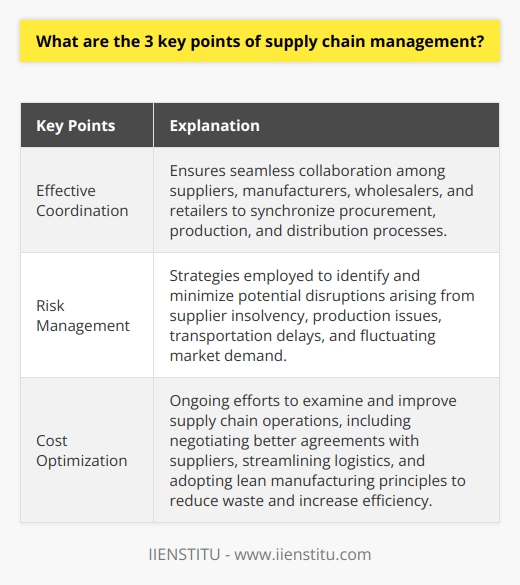
How do demand planning, collaboration, and data analysis work together to support the optimization of supply chain management?
Demand Planning in Supply Chain Management
Demand planning plays a crucial role in optimizing supply chain management by predicting customers' future needs and allowing companies to make informed decisions regarding resource allocation, inventory levels, and production schedules. Accurate demand planning reduces the chance of stockouts or excess inventory, resulting in cost savings and increased customer satisfaction.
Collaboration in the Supply Chain
Collaboration among various stakeholders, such as suppliers, manufacturers, retailers, and customers, enhances supply chain optimization by fostering trust, transparency, and information-sharing. When these stakeholders exchange data and insights, they can effectively align supply and demand, streamline production processes, and minimize delays and inefficiencies. Cooperation between parties helps create a more agile, responsive supply chain that can better adapt to fluctuations in demand, ultimately improving operational performance and profitability.
Data Analysis for Informed Decisions
Data analysis is integral to supply chain optimization because it supports both demand planning and collaboration efforts. Through the collection and evaluation of historical sales trends, seasonal patterns, and market research, companies can develop demand forecasts and fine-tune their supply chain strategies. Additionally, data analysis enables organizations to identify inefficiencies in their supply chain processes, such as bottlenecks, high transportation costs, or suboptimal supplier relationships.
Enhanced Interactions through Technology
Advancements in technology have provided platforms that facilitate demand planning, collaboration, and data analysis in the supply chain. Digital tools such as Enterprise Resource Planning (ERP) systems, cloud-based software solutions, and data analytics software enable real-time information sharing, analysis, and decision-making. These technologies help to create a more integrated supply chain that can quickly adapt to market conditions and consumer needs, resulting in optimized operational performance.
In conclusion, demand planning, collaboration, and data analysis work together to support the optimization of supply chain management by fostering a proactive and cohesive approach to meeting customer needs. By combining these elements effectively and utilizing technology-based solutions, organizations can enhance their supply chain efficiency, drive cost reductions, and ultimately achieve a competitive advantage in today's challenging business environment.
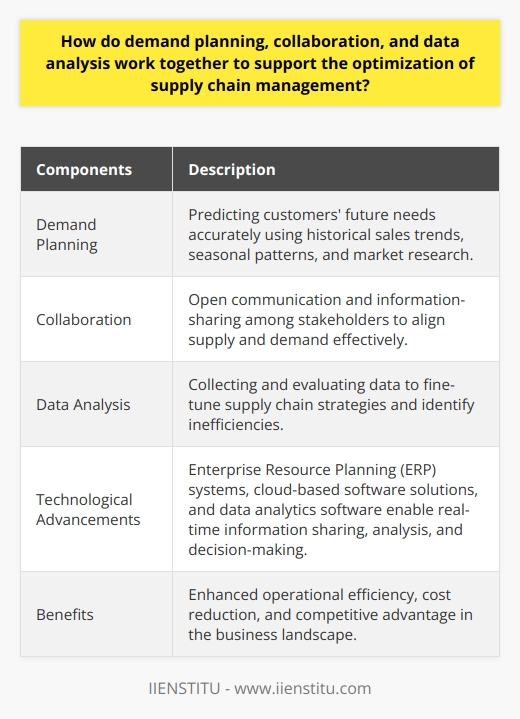
What is the key to a successful supply chain?
Effective Coordination and Communication
The key to a successful supply chain lies in effective coordination and communication among all stakeholders involved in the process. Effective communication ensures that all parties are aligned in terms of goals, responsibilities, and expectations, thereby reducing the likelihood of errors, delays, and inefficiencies.
Robust Information Systems
Implementing robust information systems is vital to enable timely sharing of accurate data between supply chain partners. Information systems facilitate real-time tracking of inventory, order status, and other essential parameters, enabling informed decision-making and continuous improvement.
Strong Supplier Relationships
Establishing strong supplier relationships is a critical aspect in maintaining a successful supply chain. Cultivating trust and transparency with suppliers helps maintain consistent product quality, ensure on-time delivery, and achieve cost savings through long-term contract negotiations.
Risk Management and Contingency Planning
Successful supply chains must effectively manage risks and have contingency plans in place to address potential disruptions. Identifying potential risks, analyzing their impact on the supply chain, and preparing suitable mitigation strategies help prevent significant losses and ensure business continuity.
Agile and Responsive Supply Chain
The ability to be agile and responsive to market changes and customer demands is a key factor in a successful supply chain. This involves adopting flexible production strategies, maintaining adequate inventory levels, and employing demand forecasting tools to stay ahead of the competition.
Performance Measurement and Continuous Improvement
Lastly, a successful supply chain systematically evaluates its performance metrics to identify areas of improvement. By tracking key performance indicators (KPIs), companies can monitor efficiency, identify bottlenecks, and drive continuous improvement to achieve a sustainable competitive advantage.
In conclusion, a successful supply chain demands effective coordination, robust information systems, strong supplier relationships, risk management, agility, and continuous improvement. By focusing on these key aspects, businesses can optimize their supply chain processes, driving increased customer satisfaction and profitability.
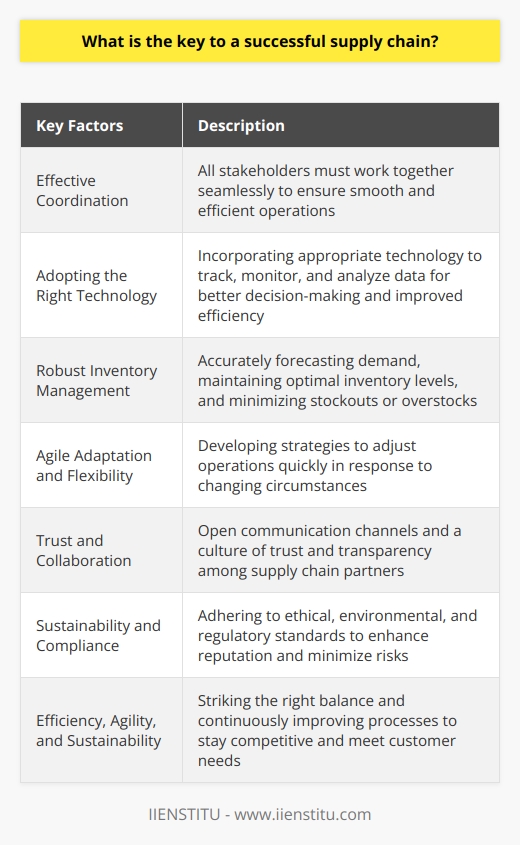
What is process optimization in supply chain management?
Process Optimization Defined
Process optimization in supply chain management is the continuous enhancement of supply chain processes, seeking to maximize efficiency, minimize costs, and improve overall performance. It is an essential component of supply chain management as it helps organizations to remain competitive and deliver the highest level of customer satisfaction.
Evaluating Supply Chain Performance
The first step towards optimization is assessing the current performance of the supply chain. This involves analyzing key performance indicators (KPIs) such as inventory levels, warehouse space utilization, order cycle time, and overall transportation cost. By evaluating these metrics, organizations can identify any bottlenecks or inefficiencies within the supply chain.
Implementing Data-Driven Solutions
Once performance gaps have been identified, data-driven solutions can be implemented to optimize the supply chain. This approach uses advanced analytics tools and techniques, such as predictive modeling and artificial intelligence, to gain insights into the supply chain, forecast demand, and optimize inventory management. By leveraging these data-driven solutions, organizations can make informed decisions that lead to a more streamlined and cost-effective supply chain.
Promoting Collaboration and Communication
Optimization is not solely about utilizing modern technologies. Fostering a culture of collaboration and communication across the organization is critical for successful optimization. Better collaboration between different departments helps to ensure that all parts of the supply chain work together effectively, which ultimately results in a more agile and responsive supply chain.
Adopting Lean Management Principles
Lean management principles can also be applied to optimize the supply chain by focusing on eliminating waste and non-value-added activities. Through process mapping and an emphasis on continuous improvement, organizations can identify areas for optimization, ranging from warehouse layouts to transportation routes. This approach can lead to significant reductions in lead times and more efficient resource allocation.
Continuous Improvement and Risk Management
Finally, the process of optimization should be ongoing and adaptive to changing market conditions and business needs. Continuous improvement initiatives help to ensure that organizations remain adaptable and resilient in the face of challenges, while also integrating risk management strategies to mitigate potential disruptions to the supply chain.
In conclusion, process optimization in supply chain management is a multifaceted approach that involves evaluating performance, implementing data-driven solutions, promoting collaboration, adopting lean management principles, and emphasizing continuous improvement. By embracing these techniques, organizations can improve their overall supply chain efficiency, cost-effectiveness, and customer satisfaction.

What are the 3 key points of supply chain management?
**Efficient Flow of Materials**
One essential aspect of supply chain management is ensuring the efficient flow of materials, from the procurement of raw materials to the delivery of finished products to the end customers. This involves coordinating the activities of various supply chain participants, such as suppliers, manufacturers, and distributors, so that the goods are produced and transported in a timely and cost-effective manner.
**Effective Information Sharing**
Another critical aspect of supply chain management is effective information sharing among the different stakeholders. This encompasses the exchange of data regarding production, inventory levels, and delivery schedules. By sharing accurate and real-time information, supply chain partners can make more informed decisions that help minimize the bullwhip effect, a phenomenon where small changes in customer demand can cause significant fluctuations in the upstream supply chain.
**Risk Management and Mitigation**
Lastly, supply chain management also involves identifying, assessing, and mitigating risks that may disrupt the normal functioning of the supply chain. These risks can range from natural disasters to supplier failures, and even political instability. By actively managing and minimizing these risks, supply chain professionals contribute to business continuity and ensure uninterrupted flow of goods to the end customers.

How do you optimize supply chain optimization?
Understanding Supply Chain Ecosystems
To optimize supply chain optimization, it is crucial to first understand the complex ecosystem that constitutes the supply chain. This involves recognizing the combination of diverse aspects like sourcing, production, transportation, warehousing, and retail sale of products. By grasping the intricate relationships among these components, businesses can design strategic actions to improve the overall functioning of the supply chain.
Data Analytics and Technology
By employing data analytics and technology, companies can streamline the supply chain operations. Collecting and analyzing data from various sources, such as customer buying patterns, supplier performance, and inventory replenishment cycles can help businesses in making informed decisions. Technologies such as Internet of Things and blockchain can be utilized to track product quality, ensuring transparency and security in the network.
Collaboration and Integration
Collaboration and integration across the supply chain partners can significantly enhance operational efficiency. By developing strong partnerships and alliances with suppliers, manufacturers, distributors, and retailers, companies can optimize the supply chain resilience, adaptability, and scalability. Integrating software systems and sharing relevant information can enable better coordination among different stakeholders, resulting in a progressive, collaborative approach.
Sustainability and Risk Management
Incorporating sustainability into supply chain management promotes long-term success and competitiveness. Companies must identify environmental, social, and economic risks in their supply chains and strive for environmentally-friendly and socially responsible practices. Sustainable operations, such as reducing waste, conserving resources, and implementing ethical labor policies, contribute to optimized supply chain management.
Continuous Improvement and Innovation
Lastly, continuous improvement and innovation are indispensable tools in optimizing supply chain optimization. By encouraging an organizational culture of innovation and learning, companies can swiftly respond to changing market dynamics and customer demands. Incorporating advanced technologies, implementing lean management practices, and adopting agile methodologies can ensure supply chain optimization and drive business growth.
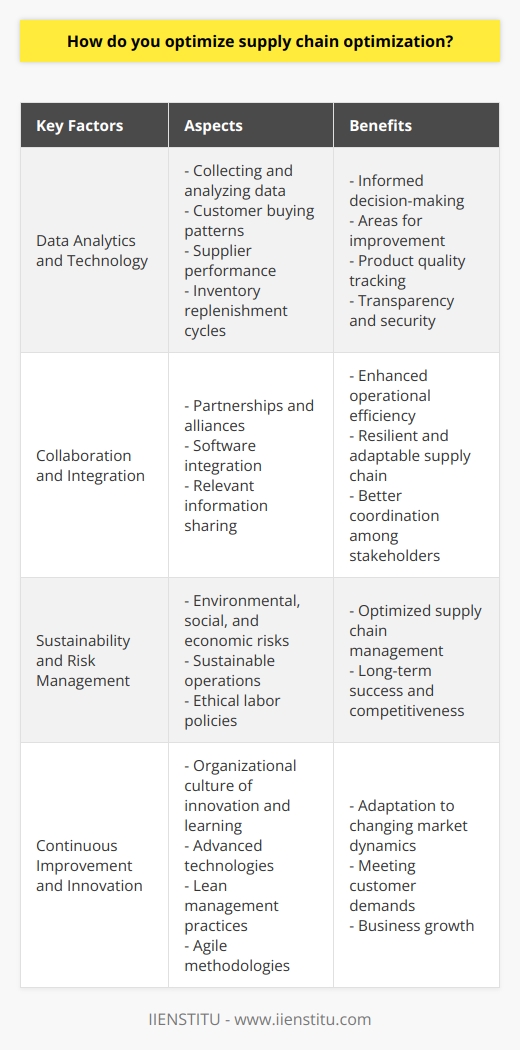
What is the key to a successful supply chain?
Essential Factors for a Successful Supply Chain
Efficient Coordination and Collaboration
The key to a successful supply chain lies in the effective coordination and collaboration among all the involved stakeholders. Various entities, such as suppliers, manufacturers, distributors, retailers, and customers, ought to work in cohesion to streamline the delivery of products and services. The development of strong relationships and transparent communication systems can help enable better decision-making, foster accountability and minimize inefficiencies in the supply chain.
Strategic Planning and Adaptability
To devise a resilient supply chain, it is crucial to engage in comprehensive strategic planning. This includes outlining long-term goals, conducting risk assessments, and forming contingency strategies to counter potential disruptions. Equally important is enhancing the adaptability and flexibility of the supply chain to respond more effectively to changing market conditions and customer demands.
Technological Integration
Harnessing technology is another vital factor for improving a supply chain's overall functionality. The integration of advanced systems, such as automation, data analytics, machine learning, and artificial intelligence, can contribute to boosting efficiency, reducing operational costs, and enhancing visibility across the supply chain. These technologies can help companies to make more informed decisions, optimize resource utilization, and monitor performance in real-time.
Sustainability Practices
Implementing sustainability practices in supply chain management is essential in the present-day business environment. Sustainable strategies involve the consideration of environmental, social, and economic factors during decision-making. Engaging in ethical sourcing, reducing carbon emissions, promoting greener practices, and maintaining fair labor policies can significantly contribute to a successful supply chain while also improving a company's reputation.
Continuous Improvement
Finally, a commitment to continuous improvement is vital for maintaining a successful supply chain. The process entails regular monitoring and analysis of supply chain performance, identification of areas for improvement, and the implementation of necessary changes. This proactive approach fosters resilience, enhances competitiveness, and ensures the overall sustainability of supply chain operations.
In conclusion, the key to a successful supply chain lies in a combination of efficient coordination and collaboration, strategic planning and adaptability, technological integration, sustainability practices, and continuous improvement. By considering these essential factors, companies can optimize their supply chain operations, thus ensuring higher customer satisfaction, reduced operational costs, and long-term business growth.

What is process optimization in supply chain management?
Role of Process Optimization in Supply Chain Management
Process optimization in supply chain management (SCM) refers to the systematic improvement of processes within the supply chain, aimed at reducing costs, increasing efficiency, and enhancing overall customer satisfaction. It involves identifying and addressing inefficiencies, wastage, and redundancies to maximize the output without compromising on quality.
Analyzing Processes in SCM
The first step in process optimization is analyzing the current status of various processes within the supply chain. This includes evaluating procurement, production, inventory, warehousing, distribution, and transportation. Data-driven methodologies such as Six Sigma and Lean Management can be employed to assess the effectiveness of each process.
Identifying Bottlenecks and Issues
The next stage of process optimization is identifying bottlenecks or constraints that hinder the smooth flow of goods and information. Identifying these bottlenecks enables organizations to prioritize and focus on resolving these issues, ultimately leading to higher operational efficiency.
Implementing Solutions and Improvements
Once the issues are identified, appropriate solutions are implemented to address specific bottlenecks or inefficiencies. These solutions could range from hardware upgrades and integration of automated systems to restructuring of warehouse layout and implementation of advanced inventory management systems.
Monitoring and Continuous Improvement
Post-implementation, it is crucial to monitor the impact of the improvements on supply chain performance. Key performance indicators (KPIs) such as inventory turnover, customer order cycle time, and order fulfilment rate can be tracked to determine the effectiveness of the implemented solutions. Continuous improvement ensures that the supply chain adapts to the changing needs of the market and maintains a competitive edge.
In conclusion, process optimization in SCM is a vital component of effective supply chain management. By analyzing and improving various processes within the supply chain, organizations can reduce costs, increase efficiency, and enhance overall customer satisfaction. It is a continuous effort that leads to enhanced supply chain performance and competitive advantage.

What is the importance of optimization in supply chain management?
Significance of Optimization
In supply chain management, optimization plays a crucial role as it seeks to enhance efficiency, reduce costs, and improve overall performance. By optimizing various aspects of the supply chain, companies can achieve a competitive advantage, foster customer satisfaction, and ensure sustainability.
Facilitating Decision Making
One of the primary benefits of supply chain optimization is that it assists in making well-informed decisions. These decisions may encompass selecting the best suppliers, determining ideal transportation methods, and identifying effective inventory management strategies. In turn, this process enables companies to manage their resources effectively and operate at their full potential.
Cost Reduction
Optimization in supply chain management aids in identifying and addressing inefficiencies, which leads to significant cost reduction. By analyzing, evaluating, and adjusting key components of the supply chain, such as logistics, warehouse operations, and order processing, managers can implement measures to streamline processes and eliminate waste. Consequently, optimized supply chains are more cost-efficient and contribute to better financial performance.
Flexibility Enhancement
A flexible supply chain is capable of adapting to changes in consumer demand, market conditions, and other external factors. Optimization efforts help in identifying bottlenecks, anticipating future challenges, and establishing adaptable operations. By incorporating flexibility into the supply chain, companies can react promptly to fluctuations, safeguarding their commercial viability.
Customer Satisfaction Improvement
An effective supply chain directly contributes to improved customer satisfaction, as it ensures that the right products reach the right customers at the right time. Through optimization, companies can enhance order accuracy, minimize lead times, and maintain high product quality levels. Customer satisfaction is inevitably higher when businesses prioritize supply chain optimization.
Environmental and Social Impact
Lastly, optimized supply chains offer environmental and social advantages. When companies strive for efficiency, they consume fewer resources and produce less waste, thereby minimizing their ecological footprint. Additionally, optimized supply chains frequently prioritize ethical sourcing, fair labor practices, and responsible production methods, which have positive social implications.
In conclusion, optimization in supply chain management is of vital importance, as it influences various aspects of a company's success. By optimizing their supply chains, businesses can make better decisions, reduce costs, enhance flexibility, improve customer satisfaction, and make a positive impact on the environment and society.
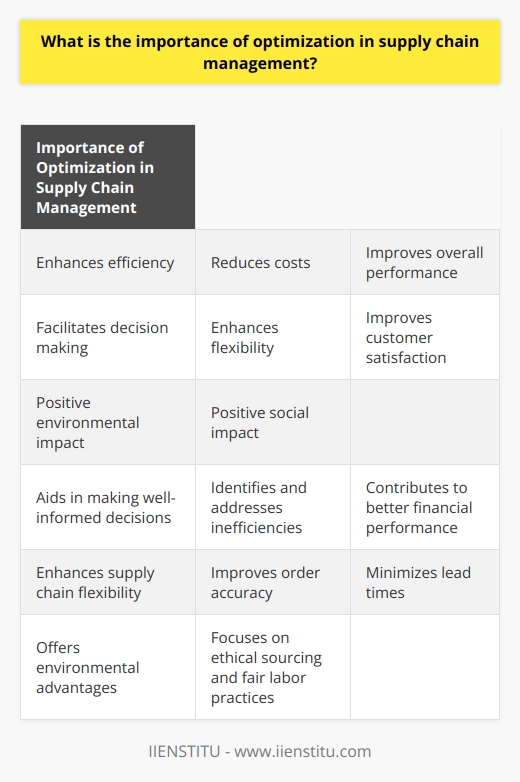
How can performance metrics and key performance indicators (KPIs) be utilized for supply chain optimization?
Utilization of Performance Metrics
Performance metrics play a vital role in supply chain optimization by providing quantitative data on various aspects of the supply chain activities. They enable the evaluation of performance in terms of efficiency, effectiveness, and alignment with business objectives. The proper utilization of performance metrics can lead to improvements in key areas of supply chain management, such as inventory management, transportation, supplier relationship management, and customer service.
Application of Key Performance Indicators
Key Performance Indicators (KPIs) are essential tools in supply chain optimization, as they measure the progress of specific targets that directly influence business success. They help identify areas where improvements are needed, allowing for informed decision-making and strategic adjustments. By setting KPIs that align with overall business goals, supply chain managers can ensure their actions contribute to the achievement of these objectives.
Inventory Management
One critical aspect of supply chain optimization is inventory management, where KPIs play a significant role. For example, by tracking inventory turnover, supply chain managers can assess how quickly items are sold and replenished within a specific timeframe. This information can help identify excess stock or stockouts to adjust procurement and production strategies accordingly.
Transportation and Logistics
Performance metrics and KPIs can also be utilized in optimizing transportation and logistics operations within the supply chain. Metrics such as on-time delivery rate, average transit time, and transportation cost can be monitored to assess the reliability and efficiency of carriers. These insights can identify areas for improvement and help managers make decisions for selecting appropriate transportation modes, routes, and carriers.
Supplier Relationship Management
Effective supplier relationship management is crucial for a seamless supply chain. Supply chain managers can track supplier performance via KPIs such as lead time, adherence to delivery schedules, and order quality. These metrics can guide supplier selection and help foster stronger relationships while ensuring that suppliers meet the organization's standards.
Customer Service
Lastly, KPIs related to customer service can contribute to supply chain optimization. Customer-centric metrics such as order accuracy, order cycle time, and customer satisfaction can help identify areas where improvements can enhance customer experience. By focusing on these KPIs, supply chain teams can ensure that customer needs are met and exceeded, driving overall success.
In conclusion, the strategic utilization of performance metrics and Key Performance Indicators in supply chain management enables organizations to optimize their operations, create stronger supplier relationships, meet customer needs, and ultimately achieve overall business objectives. By tracking, analyzing, and acting on these critical data points, supply chain professionals can drive continuous improvement and create a competitive advantage for their organizations.
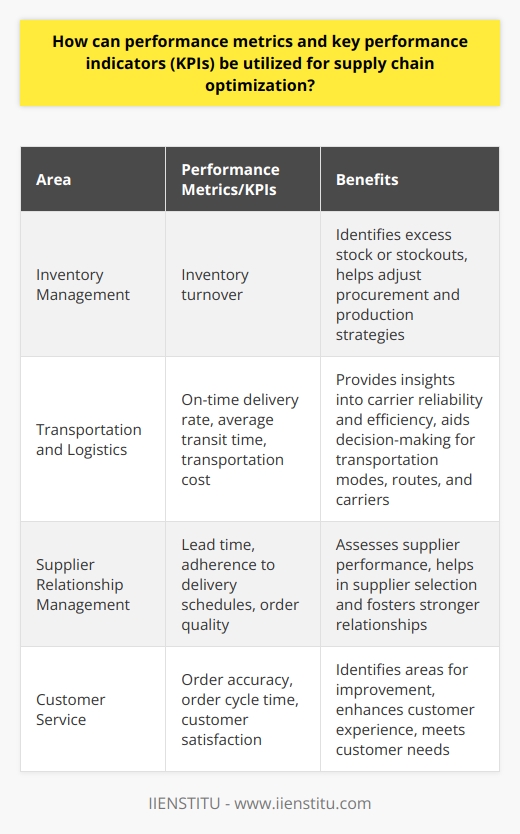
What are some practical approaches to achieving end-to-end visibility in supply chain management?
Enhancing Supply Chain Visibility
Data-driven decision-making
One of the practical approaches to attaining end-to-end visibility in supply chain management is leveraging data-driven decision-making processes. This involves the collection, analysis, and interpretation of relevant data to optimize various aspects of the supply chain, such as inventory management, procurement, and transportation.
Real-time collaboration
Real-time collaboration plays a crucial role in enhancing supply chain visibility. By fostering information sharing and communication among supply chain partners, businesses can better predict and respond to potential disruptions, reduce lead times, and improve overall performance.
Digitization and integration
Incorporating digital tools and technologies in supply chain management facilitates end-to-end visibility. Implementing systems such as enterprise resource planning (ERP), transportation management systems (TMS), and warehouse management systems (WMS) allows for streamlined data flow and better tracking of supply chain processes.
IoT and sensor technology
Utilizing the Internet of Things (IoT) and sensor technologies effectively aids in expanding supply chain visibility. These devices enable real-time monitoring of shipments and inventory, providing valuable insights into product movement, location, and condition, thereby helping businesses make informed decisions.
Blockchain technology
Blockchain technology is another approach that significantly bolsters supply chain visibility. This decentralized digital ledger technology promotes transparency, traceability, and security of information through secure and immutable data recording, making it easier for businesses to track products across the supply chain lifecycle.
Predictive analytics
The use of predictive analytics to improve supply chain visibility is a valuable tactic. By employing artificial intelligence (AI) and machine learning techniques, businesses can analyze historical and real-time data, allowing for better identification of trends, foreseeing potential disruptions, and optimizing supply chain processes.
In conclusion, achieving end-to-end visibility in supply chain management necessitates a multi-faceted approach. Deploying data-driven decision-making, real-time collaboration, and embracing digital solutions such as IoT, sensor technology, blockchain, and predictive analytics can significantly improve supply chain visibility, leading to efficient and cost-effective processes.
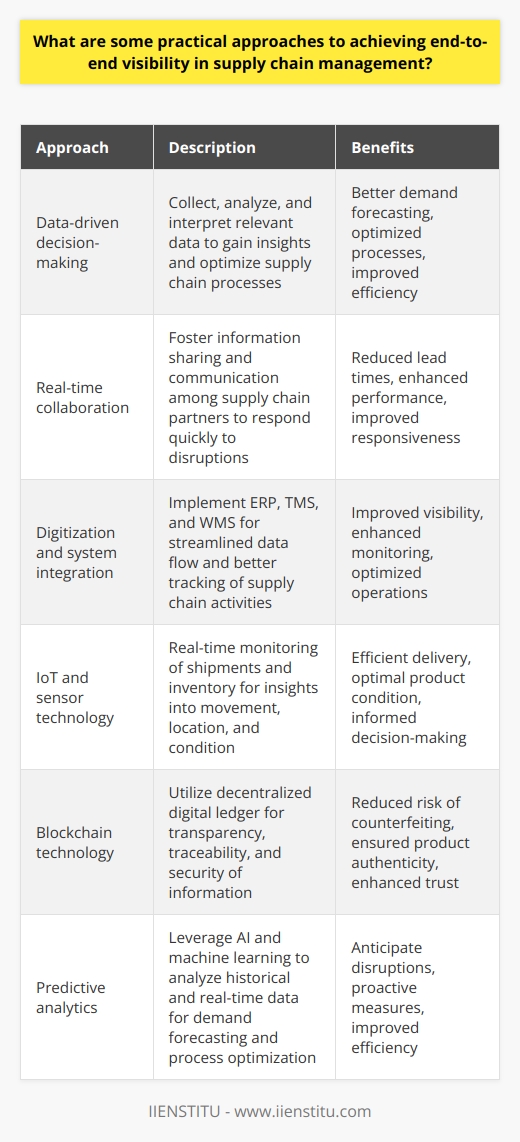
What is the key to a successful supply chain?
Key Components of a Successful Supply Chain
Effective Communication
The key to a successful supply chain lies in effective communication throughout the entire process. This involves sharing vital information between suppliers, manufacturers, distributors, and retailers, ensuring all parties are aware of the current status and any potential changes. Effective communication enables seamless operations and mitigates potential issues, resulting in a more efficient and profitable supply chain.
Integration and Collaboration
A cohesive approach between all stakeholders is essential for a well-functioning supply chain. This means establishing strong relationships between suppliers, manufacturers, distributors, and retailers, and enabling them to work together towards achieving common goals. Integration and collaboration create a more efficient supply chain that can adapt to changes in demand, manage risks, and optimize processes.
Utilizing Technology
In today's fast-paced world, leveraging technology is crucial for maintaining an efficient supply chain. This can include implementing advanced data analytics for forecasting and making informed decisions, using automation to increase productivity, and adopting innovative technologies to support operational efficiency. By staying up-to-date with the latest tech trends, businesses can ensure their supply chain remains agile, adaptive, and competitive in the market.
Supply Chain Visibility
A transparent supply chain allows businesses to monitor every stage of the process, making it easier to identify inefficiencies, bottlenecks, and potential risks. This enhanced visibility empowers companies to make proactive decisions to improve their supply chain performance. By having an in-depth understanding of the entire chain, businesses can make more informed decisions regarding sourcing, inventory management, and transportation logistics.
Flexibility and Agility
Lastly, the ability to adapt and respond to changing market conditions, customer preferences, and unexpected disruptions is critical in maintaining a successful supply chain. This requires developing a flexible and agile operational model that can accommodate fluctuations in demand, adapt to new technologies, and respond to unforeseen challenges. By cultivating resilience and adaptability, businesses can ensure their supply chain remains stable and strong, even in the face of challenges.
In conclusion, the key to a successful supply chain lies in mastering several components, such as effective communication, integration, collaboration, technology utilization, visibility, and flexibility. By maintaining a strong focus on these elements, businesses can create a robust and efficient supply chain that drives competitive advantage and long-term success.

What are the primary factors to consider when creating a supply chain risk management strategy?
Supply Chain Risk Identification
The first crucial factor in developing a supply chain risk management strategy is identifying potential risks. Risks may originate from diverse sources, such as natural disasters, political instability, economic fluctuations, or technological failures. Accurate identification ensures that decision makers are aware of potential threats and can develop appropriate mitigation measures.
Quantitative and Qualitative Assessments
An effective supply chain risk management strategy should involve both quantitative and qualitative assessments. Quantitative methods enable a standardized comparison of risks, by measuring parameters such as probability, impact, and vulnerability. Qualitative techniques, on the other hand, provide deeper insights into complex interdependencies that may be difficult to quantify.
Internal and External Stakeholder Collaboration
Collaboration among internal and external stakeholders is essential in creating a comprehensive supply chain risk management strategy. By engaging key players across the supply chain, organizations can gather valuable information about potential risks, as well as potential mitigation options. This collaborative approach also helps to build trust, foster information-sharing, and promote joint responsibility for risk management.
Supply Chain Flexibility and Resilience
Another critical factor to consider when developing a supply chain risk management strategy is the need for flexibility and resilience. A flexible supply chain can adapt to disruptions and uncertainties, while a resilient supply chain can recover quickly from adverse events. Strategies for enhancing flexibility and resilience include investing in redundant capacities, diversifying suppliers, and adopting agile supply chain practices.
Continuous Monitoring and Review
To ensure that a supply chain risk management strategy remains effective over time, organizations must commit to continuous monitoring and review processes. This involves tracking the performance of risk mitigation measures, gathering feedback from stakeholders, and staying abreast of emerging risk trends. Regular reviews help to ensure that the strategy remains current and effective, by identifying and addressing any gaps in risk management practices.
In conclusion, creating a supply chain risk management strategy requires a comprehensive understanding of potential risks and their associated consequences. A successful strategy incorporates quantitative and qualitative assessments, fosters collaboration among stakeholders, promotes supply chain flexibility and resilience, and embraces continuous monitoring and review. By implementing these key factors, organizations can build robust risk management strategies that protect their supply chains against disruptions and uncertainties.
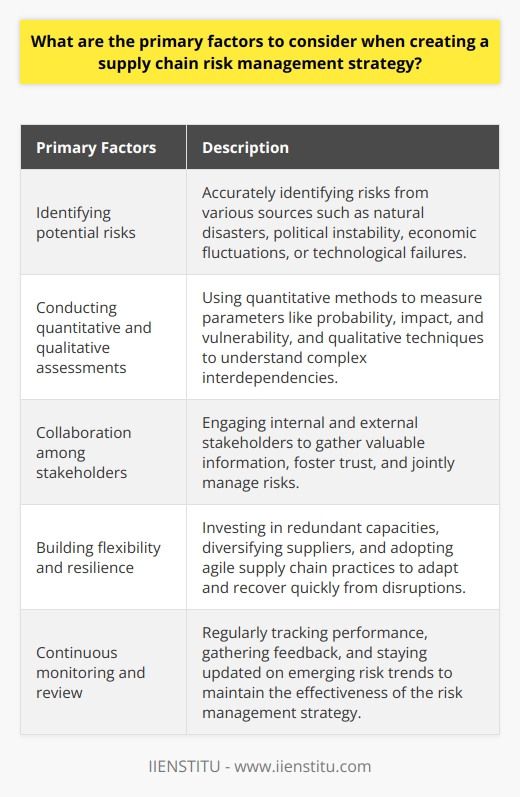
How can effective demand planning and forecasting contribute to supply chain optimization?
Importance of Accurate Demand Planning
Effective demand planning and forecasting plays an essential role in optimizing the performance of a supply chain. By anticipating customer demand with a high level of accuracy, companies can synchronize their production, inventory, and distribution plans to meet customer needs in a timely, cost-effective manner.
Reducing Inventory Costs and Expediting
One significant contribution of demand planning is the potential reduction in inventory costs. With accurate forecasting, organizations can minimize carrying excess inventory, thereby minimizing storage and handling expenses. They can also avoid stockouts, ensuring that products are always available for customers when needed. Accurate demand planning enables companies to reduce the frequency of expediting orders, decreasing transportation costs and reducing the risk of production disruptions.
Improving Production Efficiency
Another notable benefit of demand planning is the enhanced production efficiency it provides. By predicting customer demand, organizations can better manage their resources, including labor, raw materials, and manufacturing capacity. They can also optimize their production schedules to reduce lead times and increase manufacturing throughput. This allows businesses to respond more effectively to fluctuations in demand, creating a more adaptable and agile supply chain.
Enhancing Supplier Collaboration
Demand planning also encourages stronger collaboration among supply chain partners. Accurate demand forecasts facilitate better communication and coordination between suppliers, manufacturers, and distributors, ensuring that all parties can align their activities to meet customer expectations. This collaboration helps to improve the flow of materials through the supply chain, reducing lead times and mitigating the impact of supply disruptions.
Promoting Sustainability
Finally, effective demand planning and forecasting can significantly contribute to supply chain sustainability. By accurately predicting customer needs and optimizing production and distribution processes, companies can reduce waste, conserve resources, and minimize their carbon footprint. Efficient resource management not only benefits the environment but also saves the company money in the long run.
In conclusion, effective demand planning and forecasting is crucial for supply chain optimization. By accurately predicting customer needs and adjusting production and inventory strategies accordingly, companies can reduce costs, improve production efficiency, enhance supplier collaboration, and promote sustainability. Investing in robust demand planning capabilities is a critical step toward achieving a more agile, responsive, and cost-effective supply chain.
